Jeff
Vavasour's VIDEO AND COMPUTER GAME Page
Return to the
Vavasour family web site : Jeff's home page
I grew up with the Atari 2600 as a constant companion. Every
Activision cartridge I acquired, I would play relentlessly until
I had achieved the score needed to earn that game's sew-on patches. I also used to play a lot of arcade
games, so it was a thrill for me to be able to work on, in
adulthood, the very games I poured quarters into as a child. This
page mainly documents the games that I've personally programmed
since I started with Digital
Eclipse Software in 1994, though there is some other
game-related content.
Commercial Games | C-64/VIC-20 Backgammon | Activision Patches
Commercial
Games
These are the games that I've developed with Digital Eclipse:
| As
Lead Programmer... |
|
As a contributing programmer... |
Williams
Arcade Classics (MS-DOS, Window 3.1)
Activision's
Commodore 64 15 Pack (Windows 95) |
1995 |
|
Williams
Arcade Classics (Windows 95)
Williams
Arcade's Greatest Hits (Super Nintendo)
Arcade's
Greatest Hits: The Atari Collection 1 (Sony PlayStation) |
1996 |
|
| Arcade's
Greatest Hits: The Midway Collection 2 (Windows 95) |
1997 |
Arcade's
Greatest Hits: The Midway Collection 2 (Sony PlayStation)
Arcade's
Greatest Hits: The Atari Collection 1 (Super Nintendo) |
| |
1998 |
Arcade's
Greatest Hits: The Atari Collection 2 (Sony PlayStation)
Addams
Family Pinball (Windows 95, Nintendo 64)
Rampage
World Tour (Game Boy, Game Boy Colour) |
Atari
Arcade Hits 1 (Windows 95)
Q*Bert,
classic mode (Windows 95, Sony PlayStation) |
1999 |
Centipede,
classic mode (Sega Dreamcast)
Arcade
Party Pak (Windows 95)
Arcade
Party Pak (Sony PlayStation)
Rampage
2: Universal Tour (Game Boy Colour) |
Atari
Arcade Hits 2 (Windows 95)
Atari
Greatest Hits (Windows 95)
Q*Bert,
classic mode (Sega Dreamcast)
Centipede
Music CD Extra for Gruppo Sportivo (Windows 95)
Super
Breakout and Millipede (Java) |
2000 |
Shockwave
Arcade (Windows 95, Mac)
Midway's
Greatest Arcade Hits 1 (Nintendo 64)
Midway's
Greatest Arcade Hits 1 (Sega Dreamcast)
Dragon's
Lair (Game Boy Colour) |
Atari
Anniversary Edition (Windows 95)
Atari
Anniversary Edition Redux (Sony PlayStation) |
2001 |
Atari
Anniversary Edition (Sega Dreamcast)
Rayman
Advance (Game Boy Advance)
Spyro
the Dragon: Season of Ice (Game Boy Advance)
Midway's
Greatest Arcade Hits 2 (Sega Dreamcast) |
| Warlords,
classic mode in Atari Revival (Windows 95) |
2002 |
Atari
Anniversary Advance (Game Boy Advance)
Spyro
2: Season of Flame (Game Boy Advance)
Phantasy
Star Collection (Game Boy Advance) |
Atari
Pocketware (Windows 95/98/ME/XP)
Atari:
80 Classic Games in One (Windows 98/2000/ME/XP)
Midway
Arcade Treasures (Sony PlayStation 2)
Midway
Arcade Treasures (Microsoft Xbox)
Midway
Arcade Treasures (Nintendo GameCube) |
2003 |
Mini-games
in Terminator 3: Rise of the Machines (Sony
PlayStation 2)
Mini-games
in Terminator 3: Rise of the Machines (Microsoft
Xbox) |
Snap!
Classic Arcade series (Windows 98/2000/ME/XP)
Midway
Arcade Treasures (Windows 98SE/2000/ME/XP)
Atari
Anthology (Sony PlayStation 2)
Atari
Anthology (Microsoft Xbox) |
2004 |
Atari
Paddle Games 13-in-1 (Jakks Pacific TV Games)
Tron
2.0: Killer App (Game Boy Advance)
Midway
Arcade Treasures 2 (Sony PlayStation 2)
Midway
Arcade Treasures 2 (Microsoft Xbox)
Midway
Arcade Treasures 2 (Nintendo GameCube) |
| |
2005 |
Midway
TV Games (Jakks Pacific TV Games)
Namco
Museum 50th Anniversary (Sony PlayStation 2)
Namco Museum 50th Anniversary (Microsoft Xbox)
Namco Museum 50th Anniversary (Nintendo GameCube)
Namco
Museum 50th Anniversary (Windows 98SE/2000/ME/XP)
Namco Museum 50th Anniversary (Nintendo Game
Boy Advance)
Midway
Arcade Treasures 3 (Sony PlayStation 2)
Midway
Arcade Treasures 3 (Microsoft Xbox)
Midway
Arcade Treasures 3 (Nintendo GameCube)
Capcom
Classics Collection (Sony PlayStation 2)
Capcom
Classics Collection (Microsoft Xbox)
Atari
Masterpieces Vol. I (Nokia N-Gage)
Gauntlet,
Joust, Robotron: 2084, Smash TV (Microsoft Xbox 360 Live
Arcade)
Midway
Arcade Treasures: Extended Play (Sony PlayStation
Portable) |
| |
2006 |
Atari
Masterpieces Vol. II (Nokia N-Gage)
Midway
Arcade Treasures: Deluxe Edition (Windows 2000/XP)
Capcom
Classics Collection Remixed (Sony PlayStation Portable)
Konami
Classic Arcade series (Microsoft Xbox 360 Live Arcade)
Konami
Live! Online Game Controller Arcade Collection (Windows
XP)
Midway
Classic Arcade series (Microsoft Xbox 360 Live Arcade)
Sega
Genesis Collection (Sony PlayStation 2)
Sega
Genesis Collection (Sony PlayStation Portable)
Capcom
Classics Collection Volume 2 (Sony PlayStation2)
Capcom
Classics Collection Volume 2 (Microsoft Xbox)
Activision
Hits Remixed (Sony PlayStation Portable) |
More recently, I've developed the following
games:
Williams
Arcade Classics (MS-DOS, Windows 3.1) - Released 1995
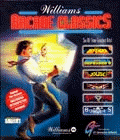 |
|
This was a classic arcade video game
compilation containing Joust,
Defender,
Robotron,
Sinistar,
Stargate
and Bubbles
plus a multimedia section featuring photos, flyer scans,
artwork, and video interviews with the programmers of the
original arcade games. This was the first product I
ever did with Digital
Eclipse. It was written 100% in assembly, and it was
an emulation. In fact, the CPU
core of this package is the very same core that was in my
freeware TRS-80 CoCo 2
Emulator. (In fact, amazingly, the CoCo 2 Emulator
was the reason I got the
job.) The only part of this product that is exclusively
Window 3.1 is the Macromedia Director-driven multimedia
history section. Even the Windows "installer"
is really just a very small program that
launches the DOS installer (which was also written in
assembly), waits for its completion, and then creates the
Windows 3.1 Program Group.
This game sold over 100,000 copies (between the
original and subsequent Windows 95/DOS
combo re-release), and, so I'm told, had the lowest
tech-support call to customer ratio of any product the
publisher had put out to date. :-)
Historical tidbits:
- This started out with the intention of being a
one-floppy project, though eventually growing to
three. (OK, technically it would've been two
floppies if I hadn't been so green on the topic
of compression at the time.) In the middle of
development, the idea was bounced around about
whether the package should be released on CD.
With the extra space, I suggested that we take
advantage of it. Programmers almost never got the
spotlight they deserved (with the exception of Activision Atari 2600
programmers in their golden era). So, I suggested
doing telephone interviews and including the
audio of that on the CD as a bonus. Andrew Ayre,
the Producer on the project and President of Digital
Eclipse did one better: he set up video
interviews which were put on the CD as a
multimedia supplement. This likely set the
standard for most all subsequent retro
compilations. Incidentally, the video interviews
were conducted by Chris Charla, then of Next
Generation magazine (eventually the
Editor-in-Chief before moving on to Daily Radar
and later, in 2001, joining our company), and Jon
Bradley Snyder, of the Official Star
Wars Fan Club.
- The package was originally only supposed to be
Defender, Joust and Robotron. While waiting for
the video interviews to be set up, I started
asking around on the newsgroup rec.games.video.arcade.collecting
about what other games ran on similar hardware.
In my spare time, I got Sinistar, Stargate and
Bubbles running. My thought was that maybe
there'd be interest in a follow-up, and I'd have
the games ready. When I showed the games, there
was immediate excitement. The package was refit
to incorporate all six.
- Officially we've got to call Stargate
"Defender II" these days because a
Ouija board manufacturer claimed prior trademark
on the name Stargate. The ROM hack I created to
turn Stargate into Defender II has since become
the "official" ROM and title artwork
for all subsequent releases of the game, in a
revisionist sort of way.
- This was Digital Eclipse's first non-Mac product.
(Yes, Digital Eclipse started out as a Mac
productivity company before switching gears in
1994 to become a game developer. I was hired as
their first non-Mac programmer.) In a tip of the
hat to Digital Eclipse's Mac legacy, if you put
the disk in a Mac, you will be able to access the
multimedia content viewer.
- This marks the one and only time I've
"programmed" for Windows 3.1, such as
it was. For the task, I'd bought a copy of
Borland C++ for Windows 3.1 that came on
something like 33 floppy disks, though the
programming was eventually done in Microsoft's
Visual C++ 1.52 instead. The source code for the
only part written in C, the Windows 3.1 installer
assistant described above, is shorter than the
HTML for just this section you're reading on Williams
Arcade Classics. Virtually everything was
DOS-based and 8086 assembly.
- With the exception of the "Arcade" game
selector art and the multimedia section, I did
everything on this one down to writing the text
for the manual.
Some classic arcade enthusiasts have installed Williams
Arcade Classics into dedicated cabinets, and have
wanted a way to make the games behave like the original
arcade cabinets. The following two patches can do just
that to the DOS version of Williams Arcade Classics.
You can install these patches seperately or one on top of
the other in either order:
- You can remove the launch menus
with this
patch.
- You can re-enable the "rug
test" power-up self-test pattern
with this
patch. (Our emulators will normally "fast
forward" past the self-test.)
View
screen shots from Williams Arcade Classics and other
games
These days, you can play the games from Williams
Arcade Classics for free from your browser via the Shockwave Arcade.
Addendum
In November of 2005, I fulfilled what
might be the longest-delayed feature request in the
history of gaming development. Almost 10 years to the day
from the game's original appearance on the shelves, I
created a single-floppy version of this game with all of
its features intact (except the multimedia interviews,
obviously). Prior to the addition of the multimedia
interviews, the hope had been to fit this package on one
floppy. At the time, I couldn't do it. I was always
disappointed with that, even if the need for this feature
vanished when the decision was made to make the CD-ROM
version. However, in 2005, using only technology that
existed in 1995, I finally completed that task.
As noted above, the reduction from
three to two floppies was possible if I'd made use of
compression. To make it happen, I took the version of the
ZLIB public domain compression routines available in
1995, compiled the "inflate" (decompressor)
portion using my dusty copy of the 16-bit Visual C++ 1.52
compiler, and then adapted the game's original installer
to link with it.
To further reduce the package from two
floppies to one, I then removed the compressed sound
samples from the disks and replaced them with a much more
compact emulator of the original Williams sound board.
The sound was always emulated, even in the version of
this compilation that was ultimately released on CD to
the public, but only in that an emulator was used to
generate the samples the game used. Those
"pre-synthesised" samples were stored in a file
which was loaded in whenever the game was started. This
had to be done because it would've been too much strain
on a 486 33MHz to emulate both the game and the sound
board on-the-fly at the same time. For my one-floppy
version, I still had the samples written to a file that
the game could load at run-time. So, the system
requirements didn't change. What I did, however, was add
my sound board emulator to the installer. When the
installer is run, it would take the time needed to
synthesise the sounds then, rather than having the
already-synthesised sounds on another installation
floppy.
Between these two changes, the entire
package, except for the multimedia interviews, could fit
on one
floppy. I was quite pleased
with the results, even if they were a little belated. The
final copy even has a home-made laser label mimicking the style of the original Macintosh
releases of Defender, Joust and Robotron, and a compact floppy
case mimicking the box art of
the eventual MS-DOS release.
At our company Christmas party in 2005,
I presented one of the three copies of this version in
existence to Andrew Ayre, who was President of Digital
Eclipse at the time, and, more
currently, Co-President of our umbrella company, Foundation 9
Entertainment. This copy, as I
understand it, is now enshrined in Mike Mika's vast
collection of obscure video game memorabilia. (Mike is an
avid classic gamer and also happens to be studio head for
our Emeryville, California-based sister studio.)
|
Activision's
Commodore 64 15 Pack (Windows 95) - Released 1995
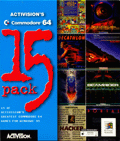 |
|
This was a Commodore 64 emulator
pre-packaged with 15 Activision-original
Commodore 64 games: Beamrider, Decathlon,
Hacker, Little Computer
People, Rock n' Bolt, Zenji,
Top Fuel Eliminator, Alcazar,
Toy Bizarre, Master of the Lamps,
Web Dimension, Portal, The
Great American Cross-Country Road Race, Zone
Ranger, and Park Patrol. This
was my first program in C and my first true program for
Windows of any kind. (I don't count the 9K Windows 3.1
installer assistant in Williams Arcade
Classics.) Surprisingly, it turned out fairly well. :-) The chief shortcoming was
sound. This was pre-DirectX and there was no
Windows-friendly method of doing the sound that the
Commodore 64 could do. Windows-friendly was particularly
important since we had to qualify for the "Designed
for Windows 95" logo, and that mandated not breaking
through the Windows API layer. Activision's Atari
2600 Action Pack had achieved more accurate
sound, but it did bypass the Windows API layer, meaning
it was specifically designed for SoundBlasters and
compatibles only. The result was something that could
misbehave and cause some major headaches.
Commdoore 64 15 Pack didn't do too well
commercially. Personally, I attribute that to the paradox
of having a package aimed at people who had an affinity
for the old school computer world, being sold for the
just-released Windows 95 platform which was aimed at the
rapid adopters with the latest hardware.
|
|
Williams
Arcade Classics (Windows 95) - Released 1996
 Download bug fix
|
|
This was a Windows 95-specific
re-release of Williams Arcade Classics. Inside
it was 95% a rewrite, though some of the 6809 core was
ported line-by-line to Win32. (Yes, the emulator was
still in assembly, though the surrounding GUI code was
now in C.) This version also contained the DOS version on the same CD, but the
Windows 95 version offered some extra features:
- Integrated multimedia - a more
polished interface that used Windows 95's native
multimedia capabilities without the need to
install 16-bit QuickTime drivers.
- Better sound - with less strict
memory requirements, all game sound samples were
44kHz 8-bit. They were also on the CD in .WAV
format, meaning you could integrate them into
your Windows sound scheme with a little effort.
- Better peripheral support -
DirectX supported a wider variety of sound boards
and controllers. The DOS version only supported
the SoundBlaster and the normal joystick port.
- Easier configuration - a
user-friendly interface was available for
changing the game options. Granted, some purists
might frown on this, preferring to see the
original arcade operator menus that the DOS
version used.
- The "pterodactyl bug"
- the earlier model of the Joust arcade machine
had a bug wherein you could kill the
"invincible" pterodactyl with ease by
standing still at a particular spot on a
particular platform, and waiting for the
pterodactyl to fly up and impale itself on your
lance. This was bad news for arcade operators as
sure-thing survival tactics like this prevented
the turn-over of players they needed to keep the
quarters rolling in. A fix was issued in later
models of the arcade machine to correct the
problem. This fixed version had been used in the
DOS version, and some purists missed not being
able to relive the pterodactyl bug in our
compilation. So the Windows 95 version included
an option that allowed you to play the older
version with the bug intact.
- Autoplay - no installation, no
launchers. Just stick the CD in and it runs. Of
course, if you preferred the older DOS version,
you just had to run INSTALL.EXE on the CD to
install it on your hard drive and then file the
CD away.
This compilation is currently believed to be out of
print and was never available in large quantities, so it
will be really hard to find. There was supposed to be a
re-release in Europe under the name Midway's Arcade
Classics Volume 1, though it hasn't hit the shelves
yet as far as I know.
The core of this version of Williams Arcade
Classics also forms the core of the free, online Shockwave Arcade versions.
|
Williams
Arcade's Greatest Hits (Super Nintendo) - Released 1996
 |
|
This was a port of Defender,
Joust,
Robotron,
Sinistar,
and Stargate
(Defender II). I was fortunate to have
made the acquaintance of Larry DeMar, one of the
programmers on Defender and later head of Williams pinball division.
He'd been kind enough to provide me with the original
source code to these games, which his team had
meticulously archived. This source code was used to
render these games as accurately as could be done without
emulation. All AI bugs and the like that created the game
play dynamic were reproduced authentically, where
possible. (Side note: he also sent a Stargate T-shirt for which I'm
most grateful, and the partial source code for an
incomplete game called Conquest. It was a cross between
Defender and Sinistar that used an encoder wheel like
Tempest's. It was an early prototype that was abandoned
due to its resemblence to Sinistar, which was more
complete at the time.) George Phillips and his brother
Peter, whom I'd met through our mutual interest in TRS-80
emulation, worked on the Genesis version of this same
package, from the same source code. George and Peter had
previously ported Williams Arcade Classics to the Sony
PlayStation for us.
On this Super NES version, I was responsible for the
ports of Defender, Joust, Robotron, and Stargate, as well
as the main structural code, while Chris
Burke (of Burke & Burke fame in the TRS-80 Colour Computer
community) ported Sinistar. John Kowalski
(another active CoCo programmer) did the meticulous
recoding of the arcade games sound for the Super NES
sound chip.
Trivia: In addition to descriptions of the
five games in the package, due to an error on the part of
the publisher, the
back of the box shows the logo for Bubbles. It is
accompanied by a brief description of the game.
Fortunately, Bubbles is a virtually unknown arcade game,
and so, I am not aware of any consumer complaints
regarding its absence.
|
Arcade's
Greatest Hits: The Atari Collection 1 (Sony PlayStation) - Released 1996
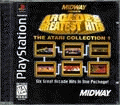 |
|
This package contained authentic
emulations of Asteroids,
Battlezone,
Centipede,
Missile
Command, Super
Breakout, and Tempest
including video interviews with the original designers. The
Atari games are my favourites. For a long time this was
my favourite package (until Atari Greatest
Hits on Windows 95). It is still my favourite package
at times, because there's nothing like lounging in front
of the uncomplex TV playing video games on a machine that
was built exactly for that. And, these games were
emulations, so the authenticity was there. (Finally, I
could play Asteroids the way I, as a naive 10-year-old,
had expected it to look when I plugged in my Atari 2600
Asteroids cartridge for the first time.)
For this project, I coded the emulators, historical
slide show, and in-game menus, while Tod Frye created
main game selection menu, drawing code for the
vector-based games like Asteroids, plus the memory card
code, video playback and file support. The opening
animation sequence and arcade cabinet
"stonehenge" was created by Boyd Burggrabe
(then, soon-to-be Art Director of Digital Eclipse),
with some concept input from me. Sadly, I'm the one to
blame for the in-game menu "programmer art." :-)
This game was a fair success, selling something in the
neighbourhood of 400,000 copies. It's out of print now,
but I enthusastically recommend you pick up a copy of Atari Anniversary Edition Redux
instead. Atari Anniversary Edition Redux is a
totally revamped Atari collection featuring 12 games
(including the six from Atari Collection 1) and
a thoroughly redesigned and upgraded interface with a
host of extras not found in Atari Collection 1.
(Anniversary Edition doesn't contain the
interviews with Ed Logg, Ed Rotberg and Dave Theuer,
however. Instead, there is an equally-interesting
interview with Atari founder Nolan Bushnell. Those
interested in Atari history may want to complete their
collection with both versions, however.)
Incidentally, as a testament to this project's long
hours, the in-game credits dedicate this game "to
the programmers' computer widows and orphans," which
tells me that at least one thing remained unchanged
between Atari Collection 1 and Atari
Anniversary Edition Redux. :-)
|
Arcade's
Greatest Hits: The Midway Collection 2 (Windows 95) - Released 1997
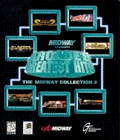 Download bug fix
|
|
A follow-up to Williams
Arcade Classics which featured Joust
2, Root
Beer Tapper, Splat!,
Moon
Patrol, Spy
Hunter, BurgerTime,
and Blaster
plus video interviews with the original designers in the
form of a trivia game. Just to clear something up:
there is no game called Midway Collection 1 on
Windows 95 or the PlayStation. Williams changed its name
to that of its sister company, Midway (probably to share
in the name recognition Midway had got as a result of
Mortal Kombat, NBA Jam, etc.). So Williams
Arcade Classics would've been known as The Midway
Collection 1 had it been released after the name
change. The publisher pretended that this was the case
and so this package was now Midway Collection 2.
This was basically a solo project, with the game
chooser art and trivia game content borrowed from the PlayStation version of the same
compilation. The narrator of the trivia game,
incidentally, is Luke Porter, a high-school friend of
mine attempting his best impersonation of a
Monty-Python-style game show host with shiny teeth.
Many people ask, "what is Splat?" Splat! was
a game that Midway (then called Williams) developed and
field tested, but never released as Atari beat them to
the market by a few months with their similarly-themed
Food Fight. Splat! was built on the same hardware as the Williams Arcade Classics games, and
designed by John Newcomer who also created Joust. The
game definitely isn't a "Greatest Hit" but was
originally intended to be marketed as a bonus "never
before released lost classic". That's why there's
seven games in this package instead of the usual six.
Incidentally, Root Beer Tapper, Spy Hunter, and Moon
Patrol incorporate a 32-bit modification of the Z-80 core
I'd written for my own TRS-80
Model III/4 Emulator prior to joining Digital Eclipse.
View
screen shots of some of the games in The Midway
Collection 2
This compilation is currently believed to be out of
print and was never available in large quantities, so it
will be really hard to find. There was supposed to be a
re-release in Europe under the name Midway's Arcade
Classics Volume 2, though I don't believe it ever
hit the shelves. More recently, the games in this
compilation were rolled into Midway
Arcade Treasures for Windows. Also, Spy Hunter and
Root Beer Tapper can be played for free straight from
your browser via Shockwave Arcade.
|
Q*Bert classic
mode (Windows 95, Sony PlayStation,
Sega Dreamcast)
- Released 1999 (2000 on Dreamcast)
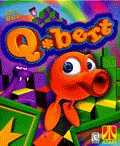 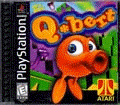
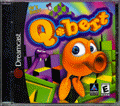
|
|
This was an experiment. The updated
version of Q*Bert was developed by Artech Studios. Digital Eclipse,
having a reputation for classic gaming, got the job of
doing the classic Q*Bert mode in this update. The
interesting thing about this rendition is that, although
the original game play was rendered precisely through
emulation, the screen graphics were re-interpreted by
Artech using their update's 3D engine. This was
accomplished by having the emulator read the contents of
the emulated game's screen, but rather than displaying
them on your computer's or console's screen, the context
of the data was interpreted to see what was going on the
screen, and corresponding changes were made in the
environment rendered by the 3D engine. The basis of
this same technique was used to create the enhanced modes
which are featured in Atari Greatest Hits.
|
Atari Arcade
Hits 1 (Windows 95)
- Released 1999
Atari Arcade Hits 2 and Atari Greatest Hits
(Windows 95) - Released 2000
Atari Anniversary Edition (Windows 95) -
Re-released 2001
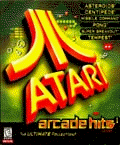 Download bug fix
(needed for original 1999 release of Atari
Arcade Hits 1 only)
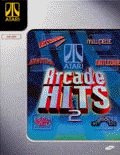

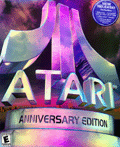
|
|
Atari Arcade Hits 1 had a wealth of
features:
- 100% emulated versions of Asteroids,
Centipede,
Missile
Command, Super
Breakout and Tempest,
plus an exact replica of the original behaviour
was reproduced exactly from a Pong.
(Pong can't be emulated since it doesn't have a
CPU. Nonetheless, it's study of the original
machine's circuit board and a working unit.)
- A fascinating (if I do say so) 30+ minute video
interview with Atari's founder, Nolan
Bushnell
- A tonne of multimedia provided by Sean Kelly and
John Hardie of the Classic Gaming Expo
fame
- Six desktop themes (wallpaper, icons, sound
schemes, screen savers, classic game fonts, and
cursors), one in the theme of each game
- A quick-launcher task bar icon
- The ability to play the games in their original
authentic look or a subtly visually-enhanced
variant
- The rare "Tempest
Tubes" variation of Tempest
Atari Arcade Hits 2 contained Asteroids
Deluxe, Battlezone,
Crystal
Castles, Gravitar,
Millipede
and Warlords,
complete with all the features of Atari Arcade Hits 1
(though instead of an interview with Nolan Bushnell, it
included an excerpt from Leonard Herman's Phoenix: The Fall and
Rise of Videogames).
Most recently, these two games have been repackaged
onto a single CD called Atari Anniversary Edition
and before that as a 2 CD set called Atari Greatest
Hits.
This was a labour of love. You might notice the number
of games I produced in more recent years has dropped off.
That's because I'd moved into a more senior position at Digital Eclipse,
rather than acting as programmer on specific projects.
This one, however, was close enough to my heart that I
decided to drop back into the trenches and tackle it
personally (albeit with support from Ryan Thom, a
newly-hired junior programmer at our Vancouver office who
was responsible for the GUI and DirectX infrastructure).
Though I loved the way Atari
Collection 1 turned out on the PlayStation and
enjoyed playing it, it was still a thorne in my side that
the best that PC users had was Microsoft Arcade, a
play-in-a-window inaccurate port of these great arcade
classics.
Every aspect of Atari Arcade Hits was fussed
over, so that it would be right this time. The
reproduction of Pong started out as a simulator of the
very wiring and TTL circuitry of the original machine.
Unfortunately, that simulator needed a computer about 50x
more powerful than the target minimum system.
Nonetheless, the simulator was used to guide the coding
of the most accurate reproduction of Pong possible. There
is one significant deviation from the original Pong,
however: We were asked to add a 1-player mode. The
original Pong could only be played by two human players
as it had no AI. To maintain the sense of authenticity,
our computer AI with the default settings plays by the
exact same rules as the AI found in Atari 2600 Video
Olympics did.
IMHO, this is the best version of these games you can
find on the PC (which you can now find as part of Atari: 80 Classic Games in One). The
package is more polished than MAME, for example, as a
commercial product is expected to be. It is chock full of
features and extras that, as a consumer, I'd probably
find worth it all by themselves. Even if you've got
Microsoft Arcade, I'd suggest getting this, to see the
games done with love and justice.
As a thanks for this project, Shahid Ahmad, the Hasbro
Interactive-based Producer on both original volumes of
Atari Arcade Hits, sent me this limited edition Atari lighter. All the team also
got cool stuff like Atari T-shirts, tote bags, etc.
|
Centipede
Music CD Extra for Gruppo Sportivo - Released 2000
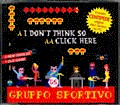 |
|
Gruppo
Sportivo is a popular Dutch band from the '80s.
Following the trend of retro-revival that brought back a
variety of '80s bands including Blondie, Platinum Blonde,
and others, Gruppo Sportivo released a retro-themed CD
Single. In keeping with the theme, as a multimedia bonus,
the CD bundles in Atari Arcade Hits'
version of Centipede as a stand-alone program. The game
is accessible by putting the music CD into your
computer's CD-ROM drive. Brought to us by the Holland
division of Hasbro Interactive and mediated by their UK
office (where Shahid Ahmad had served as Producer on Atari
Arcade Hits 1 and 2), this was definitely a
unique opportunity. It was also a fairly painless one. It
took less than an hour to rip Centipede out of Atari
Arcade Hits and make a stand-alone version with its
own configurations.
|
Super
Breakout and Millipede (Java) - Released 2000
 |
|
These two games were developed as
Java-based emulations which, at the time, you could play
over at Games.com.
(After a change of ownership, the site no longer seems to
carry the Atari-branded games.) Admittedly they don't
live up to the glory of Atari Greatest
Hits, residing in a little window like that and
suffering from all that Java overhead, but it's a good
way to get a quick Super Breakout or Millipede fix if you
want a quick distraction rather than the full immersive
experience of Atari Greatest Hits. |
Atari
Anniversary Edition Redux (Sony PlayStation) - Released 2001
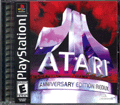 |
|
When Infogrames purchased Atari, they had big plans
for the brand. One of these plans was to commemorate the
celebration of the 30th anniversary of Atari's
formation, and the subsequent release of Pong. One of the
first steps in this plan was the multi-platform release
of Atari Anniversary Edition for PC,
Dreamcast, and Sony PlayStation. The
PlayStation version, bearing the "Redux" tag,
is unique in that we were asked to replace Millipede and
Crystal
Castles with Space Duel
and Black
Widow. So, the 12 games in this version are Asteroids,
Asteroids
Deluxe, Battlezone,
Black
Widow, Centipede,
Gravitar,
Missile
Command, Pong,
Space
Duel, Super
Breakout, Tempest,
and Warlords.
I believe Atari Anniversary Edition Redux is the
only home release of Atari's Robotron-inspired
shooter, Black
Widow, and one of the very few places you can find Space Duel
for the home.
The package includes all the combined features from
the other platforms (except for the desktop themes,
obviously). That means:
- As always, the games are fully emulated using
Digital Eclipse's proprietary Digital Arcade
Emulation Technology. So they are 100% accurate,
- The option to show the original cabinet artwork
around the edge of the playfield,
- A 30+ minute video interview with Atari's
founder, Nolan Bushnell,
- About 200 photos of Atari memorabilia provided by
Sean Kelly and John Hardie of the Classic Gaming Expo
fame,
- Rare photos of the full Black
Widow cabinet art courtesy of Roy Kaplan,
- Excerpts from Leonard Herman's Phoenix: The
Fall and Rise of Videogames, and
- Enhancements such as the rare Tempest
Tubes variation of Tempest created by Duncan
Brown, both the cabinet and cocktail variations
of Warlords,
and a special multi-colour version of Battlezone.
With 12 games in sleeker,
redesigned-from-the-ground-up presentation, this package
has superseded Arcade's Greatest Hits:
The Atari Collection 1 as the definitive Atari
collection for the PlayStation 1. Like The Atari
Collection 1 before it, it edges out the PC versions
because of the simplicity of being able to stick the game
disk in your PlayStation console and just play.
Except for some memory card library code borrowed from
Tod, one of our contract programmers, I coded this one
entirely solo. This will probably mark the last console
game I ever make entirely on my own. As a point of
trivia, Atari Anniversary Edition Redux was entirely
developed on a debugger Sony PlayStation unit with PC
link cable, rather than a full PlayStation development
kit. Hardware-wise, this was exactly what the Net Yaroze
was, except that my set-up could read CD-Rs. The Net
Yaroze was available from Sony for a time for hobbyists
at a cost of $700 US. Sony apparently stopped accepting
new subscribers into the Net Yaroze programme in
September of 2001.
When it came time to burn master disks, it was pretty
tricky. As the external Sony hardware for creating
PlayStation 1 CD masters only worked under Windows 3.1, I
had created a 100MB Zip Disk
with MS-DOS and Windows 3.1 that I could use as an
alternate boot volume fo rmy desktop computer when I
wanted to burn a new disk. Since MS-DOS/Windows 3.1
couldn't read my mutli-gigabyte hard drive, the
PlayStation executables to be burned would also reside on
the Zip Disk in a subdirectory, and the additional source
media (which changed more rarely) would reside on a CD-R
in my computer's internal CD drive. The trick was to do
everything quickly in order to make sure the source CD-R
didn't spin down during the burn process, or there'd be a
data underrun to the Sony burner, which had no buffering
to speak of.
Easter egg: go to the
Archive's Photo Gallery, then hold down L1 while
pressing, in sequence, Up, Down, Up, Down, R2. You will
get a group shot of the Digital Eclipse Vancouver studio.
|
Warlords,
classic mode in Atari Revival
(Windows 95)
- Released 2002
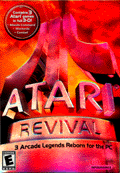 |
|
Infogrames wanted an authentic classic
version of Warlords to complement their
"modernised" version that they intended to
release as part of Atari's 30th anniversary celebration.
As we'd previous done just such a version of Warlords for
them in Atari Anniversary Edtion (and
its various previous incarnations), we naturally were
asked to adapt it for this package. The Warlords
emulation itself is identical to what was released in Atari
Anniversary Edition. It also includes all the
configurations options relevant to Warlords through a
trimmed-down configurations screen I adapted from Ryan's
menu code for Atari Anniversary Edition.
Classic Warlords was our only contribution to this
package, though it does also feature an updated rendition
of Warlords as well as updates of Missile Command and
Combat, all developed by other studios.
|
Atari
Pocketware (Windows 95/98/ME/XP) - Released 2003
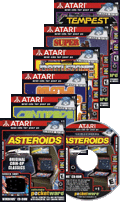 |
|
Selectsoft
Publishing's Atari
Pocketware was a novel side-project. It consisted of
a series of six collectible "mini-CDs" -- each
about the side of a bubblegum trading card (a little
smaller than 3" by 4"). They were similar to
other mini-CDs except that the normally-circular CD was
cropped on two sides to fit in its small box. Each disk
in the series contained one of six classic titles that
Selectsoft had licensed from Atari: Asteroids,
Centipede,
Missile
Command, Battlezone,
Super
Breakout, and Tempest.
We extracted these six games from Atari
Anniversary Edition and Selectsoft
wrapped it in a new installer. Since all was involved
was extracting the emulators I'd written for Atari
Anniversary Edition (along with their setup
screens), work on this one was pretty straightforward.
However, I feel the idea of presenting these games as
trading cards is pretty novel. They're probably worth
getting for the packaging alone.
Visit the official Atari
Pocketware site at Selectsoft
Publishing.
|
Atari: 80
Classic Games in One (Windows 98/2000/ME/XP) - Released 2003
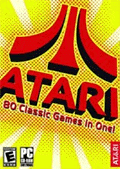 Download bug fix and
updates (includes crash bug
fixes, support for the optional Stelladaptor
controller, additional control options and improved
wallpaper; see the readme for details)
|
|
This one is easily the ultimate Atari
collection we've done to date. Part of the
collection includes the same arcade games as Atari Anniversary Edition, but
that's only the start. There are also six new arcade
emulations never before released on the PC, and also 67
Atari 2600 games in our brand new Atari 2600 Emulator.
(Minor bit of trivia, the packaging says "80 Classic
Games" for marketing reasons, but if you count them,
there are actually 85. We consider five of them a
not-so-subtle Easter egg.) The full line-up includes:
- 18 classic Atari arcade games: Asteroids,
Asteroids
Deluxe, Battlezone,
Black
Widow, Centipede,
Crystal
Castles, Liberator,
Lunar
Lander, Gravitar,
Major
Havoc, Millipede,
Missile
Command, Pong, Red
Baron, Space
Duel, Super
Breakout, Tempest,
and Warlords.
(Arcade titles appearing for the first time are
in bold. All of the enhanced modes of Atari
Anniversary Edtion are still there, too.)
- Officially, 67 classic Atari 2600 games: 3D
Tic Tac Toe, Adventure,
Air-Sea
Battle, Asteroids,
Basic
Programming, Battlezone,
Blackjack*,
Bowling,
Breakout,
Canyon
Bomber, Casino,
Centipede,
Circus
Atari, Codebreaker,
Combat,
Crystal
Castles, Demon
to Diamonds, Desert
Falcon*, Dodge
'em, Double
Dunk, Flag
Capture, Football,
Fun
with Numbers (a.k.a. Basic
Math), A
Game of Concentration, Golf,
Gravitar,
Haunted
House, Home
Run, Human
Cannonball, Math
Gran Prix, Maze
Craze, Millipede,
Miniature
Golf, Missile
Command, Night
Driver, Off-the-Wall*,
Outlaw,
Quadrun,
Radar
Lock, Realsports
Baseball, Realsports
Football, Realsports
Tennis, Realsports
Volleyball, Sky
Diver, Slot
Machine, Slot
Racers, Space
War, Sprintmaster*,
Star
Raiders, Star
Ship, Steeplechase*,
Stellar
Track, Street
Racer, Submarine
Commander, Super
Baseball, Super
Breakout, Super
Football, Surround,
Swordquest:
EarthWorld, Swordquest:
FireWorld, Swordquest:
WaterWorld, Video
Checkers, Video
Chess, Video
Olympics, Video
Pinball, Warlords,
Yars'
Revenge. (The five "hidden" 2600
games are in this list, marked with an asterisk.)
In some sense, this collection was 10 years in the
making. Since before I joined Digital Eclipse,
I had always wanted to do a licensed Atari 2600 emulator.
Back in 1993, I had developed a prototype Atari 2600
emulator, but I felt that, to be done properly it should
be bundled and marketed with the game ROMs. Not knowing
where to start with Atari at the time, I approach Activision with
hopes of getting their interest. Coincidentally, they
were just about to commission their first Atari
2600 Action Pack for Windows 3.1. Unfortunately, my
emulator was DOS-based and while I felt Windows 3.1
wouldn't support a proper emulation at the time, having
the emulator Windows-based was essential to Activision's
strategy. So, we parted ways, and their Windows-based Atari
2600 Action Pack emulator was developed by Mike
Livesay's Livesay
Technologies instead. (Trivia: I was credited in the
original Windows 3.1 release of the aforementioned 2600
Action Pack, anyway, for having contributed one of
the ROM images. I did, however, work on the Commodore 64 15 Pack with Activision a
couple years later.)
So the technological tinkering that went toward
creating a polished Atari 2600 emulator of my own largely
went by the wayside for 10 years, until the new Atari (then Infogrames)
decided they wanted to do a "mega" compilation
with everything they could legally include from their
library. (If you're wondering why famous and infamous
titles like Pac-Man,
Space
Invaders, and E.T.
aren't in the package, it's because those were only
licensed back in the day. Atari doesn't own them.) I
dusted off my emulator, severely reworked it and fit it
into a Win32 (Windows 95/98/ME/XP) framework, and thus
created the emulator that runs the home renditions in Atari:
80 Classic Games in One. Additionally, the arcade
emulators were either newly written, or else rebuilt from
the ground up in order to unify the look and feel, add
features, and make sure the latest controller and Windows
XP support was up to scratch.
Like most all my Atari projects, this was essentially
a solo effort with me as the only programmer on the task.
(Likely this will be this last project for which I'll be
able to claim that honour.) The only exception was the
desktop theme selector that comes with the package, and
the InstallShield installer script, both of which were
written by Colin (who was also a contributing programmer
to Spyro 2, among other projects at
our office). Actually, for the theme selector Colin made
some use of Ryan Thom's old code from Atari
Arcade Hits 2, so a very small part of that older
package does survive in this latest incarnation. It is
otherwise all new, re-written by myself. On the art side,
the new interface art (in a space theme) was done by
Anna, one of our diligent and talented artists in the
Vancouver office. The new desktop theme art was done by
one of our many Ryans, with help from Kierston.
There are a number of new features in this package
with which I'm quite pleased:
- In the Atari 2600 emulator, I created what I
called a "hint
book" feature.
Many -- if not most -- of these Atari 2600 games
cannot be fully understood without their manuals.
At the very least, there are game variations,
difficulty settings, etc. that are represented on
screen, if at all, by just a selection number.
Additionally, some variety and subtleties of
controls (particularly in the sports games) and
game play itself may not be immediately
self-evident. The "hint book" was a
pop-up set of "crib notes" with pages
for game selection, control setup, and a brief
explanation of game play. This pop-up can be
turned on/off manually, or otherwise will
auto-hide whenever a game is started, reappearing
when a new game selection is made.
- The audio and video
are sampled directly from my own
Atari 2600, which has been with my family since
1977. I wrote two small Atari 2600 programs. One
would cycle through all available colours on the
2600, displaying the corresponding colour code in
a barcode form at the top of the screen. The
other would cycle through all possible sounds the
2600 could generate, playing them at
predetermined intervals, marked by audio
"punctuation". I used my TV capture
card in my home PC to capture this information
and process and analyse both the audio and video,
generating both an idealised colour palette and
an idealised set of sound samples, calculated
directly from that captured Atari 2600 output.
This was all to get the best audio and video
match possible with a real first-generation Atari
2600 console.
- The controls are highly
configurable. I tried to set it
so that virtually any key and any control could
do anything. This is something I started with
Atari Arcade Hits, and continued here. The idea
was two-fold: first, it would allow people with
the proper peripherals the flexibility to
configure a more authentic control experience.
Second, it would allow people with custom
controllers (such as arcade cabinets and arcade
controls for their PC) to match up those
authentic arcade controls in a way that could be
mapped properly throughout all the games. As a
side effect of this, a feature is that, not only
can you play Pong against yourself, but you can
potentially configure all four players of Warlords
or Quadrapong (in Video Olympics) to be
playable with one hand: player 1 would be moved
by the X-axis, player 2 by the Y-axis, player 3
by the joystick rudder axis, and player 4 by the
throttle.
- A playable version of the prototype
Atari 2600 Tempest is buried
within the game, if you know where to look.
(Hint: where would you look to find out more
about Tempest, anyway?) There are also other
exciting 2600 ROMs buried in similar places,
including a great variant of 2600 Combat created
by one of Digital Eclipse's own former interns,
Zach Matley.
- The package includes scans
of manuals, comics, etc. from all
the Atari 2600 cartridges included in the
package. (Trivia: a number of those scans --
probably about 1/5th of them, including the Atari
2600 owner's manual as well as a scan from the
Sears catalogue for the original launch of the
Atari 2600 -- come from my own collection. You
can mostly tell which ones are mine: they aren't
attributed to anyone, and are international
versions with multilingual covers and manuals.
The other unattributed scans come from Mike Mika,
my fellow Atari 2600 enthusiast in our
Emeryville, California office.) Beyond, as
before, that there's bonus material for the
arcade games, including our timeless video
interview with Nolan Bushnell about the
foundation and rise of Atari, and other material
which has appeared in previous compilations.
Anyway, being the realisation of a 10-year-old
ambition, needless to say, a lot of care went in this
package. My hope is to one day bring Atari: 80
Classic Games in One to gaming consoles and
portables, because I really think it's a great package
and one of which I'm very proud.
Addendum: we made strides toward realising
that goal in 2004, with the release of Atari Anthology on the PlayStation
2 and Xbox.
|
Midway Arcade
Treasures (Sony PlayStation 2, Microsoft Xbox, Nintendo GameCube) - Released 2003
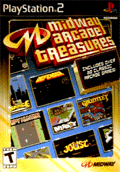 

|
|
Midway Arcade Treasures is our
biggest console-based classic game compilation to date:
24 games in one package, for three platforms. The choice
of games in this package, chosen by Midway, is entirely
derived from every game we'd previously done for Midway
that they still had the rights to publish, a selection
combined from Williams Arcade Classics,
Midway Collection 2, Atari Collection 2, and Arcade Party Pak. (Note: those packages
had slightly different line-ups on the consoles vs. the
PC versions. Due to legalities and the integrity of the
source material, the PC versions were used as a basis for
these compilations. This isn't the first time we've done
that; the Nintendo 64 and Dreamcast renditions also used our
PC-based emulation cores.) The line-up included:
- 720°,
Blaster,
Bubbles,
Defender,
Stargate
(as Defender II), Gauntlet,
Joust,
Joust
2, KLAX,
Marble
Madness, Paperboy,
Rampage,
Rampart,
RoadBlasters,
Robotron,
Satan's
Hollow, Sinistar,
Smash
TV, Splat!,
Spy
Hunter, Super
Sprint, Root
Beer Tapper, Toobin',
and Vindicators.
As a matter of trivia, the line-up did vary a few
times during development. Attendees of the 2003 Classic Gaming Expo
would have seen an early version that included a
completely playable Moon
Patrol, but alas (as noted elsewhere) Midway
was unable to secure the licence to include it in the
final line-up.
When we were approached to do this package, it seemed
reasonable: put all the games we'd done before in one
package. The catch, of course, was the time. We'd been
suggesting for about three years that a compilation such
as this would be a great idea. First time it came up, it
was conceived as a PSOne (original-generation
PlayStation) product with all the games on one disk. One
problem, though, was that, with audio samples and the
like, they simply wouldn't fit. Some schemes were devised
to work around this, but the idea never reached fruition.
Later, we created a PC prototype with all the above PC
compilations on one disk -- using a lot of compression. :-) -- but didn't get any
significant response on it. We'd eventually resigned to
the idea that this compilation wasn't going to happen
when, just before this Summer, we get a surprise call
from Midway that they were quite excited to do the
compilation of compilations after all, but on the console
rather than the PC.
Well, that was fantastic, as the consoles had advanced
considerably and it allowed us to improve a number of
things over the original PSOne releases. The downside
was, for a compilation to come out for Christmas, typical
manufacturing lead times, etc., in this business require
you to be finished in September. We had our work cut out
for us: 24 games times three platforms (more if you count
the effort needed to bring the games to the European PAL
format) and only a few months to do it.
We had to bring in the big guns on this. George and
Peter Phillips, the brothers who'd worked on the original
Williams Arcade's Greatest Hits on the
PlayStation, among others, were on this as soon as
possible. I was wrapping up Atari:
80 Classic Games in One, too, so the double-duty
to get this thing going with no time to spare resulted in
some crazy 300+ hour months (sustained 14 hour days for
3-4 months, in fact, with no weekends off). It was a
serious marathon for all of us. We called on some other
old alumni along the way: Phil, who led the console work
on the earlier Nintendo 64-based emulation,
initially led the GameCube-specific work. Ryan, who'd
done the DirectX parts of Atari Arcade
Hits, lead on the Xbox and contributed to the
PlayStation 2 version. We also brought in Tod Frye as a
contractor to help on the PS2 side, who'd previously
helped out on Atari Collection 1
for the PSOne. I was nominally leading the coordination
of this effort from a technical perspective, and liaising
with the publisher, but it was most definitely a team
effort, and an extremely intense one at that.
As a side note: one of the things we were asked to do
was to bring over all the previous video interviews and
bonus material from the earlier compilations. (Due to
various constraints, we weren't permitted the opportunity
to add any new material.) Anyway, no offence to the
original programmers who brought these games to life, but
having checked out the conversion of these videos
repeatedly, to PS2 NTSC (North America), PS2 PAL
(Europe), Xbox, and GameCube, not to mention still having
them imprinted in my brain from repeated viewings while
developing the earlier compilatons, I can say I'm really
quite done with watching them. :-)
Sadly, I can now lip-sync to these interviews. (More
sadly, I have indeed done so during a few late night
testing sessions... pretty well all 76 minutes of them,
in fact.)
Anyway, the result is a mega-collection for all three
of the major consoles: PlayStation 2, Xbox, and GameCube.
Though the PS2 can run PSOne games, this compilation is
superior to its PSOne predecessors on several points:
- The original six from Williams Arcade's Greatest
Hits (Joust, Defender, Robotron,
Sinistar, Stargate and Bubbles)
now support the Dualshock controller, which
wasn't available at the time of WAGH's original
release.
- The aforementioned six games now do smooth
"anti-aliasing" to fit your TV. The
original PSOne hardware was more restrictive and
resulted in ripples in the playfield of games
like Defender, Joust, etc.
- The PS2, unfortunately, has a flaw in its ability
to play a very small portion of PSOne games. It
affects less than a fraction of a percent of the
PSOne library, but unfortunately, our old PSOne
versions of Smash TV, Paperboy and 720° (among
others) were among that small fraction. The new
PS2 releases work correctly on the PS2
(obviously).
- The frame rates on some of the previous Midway
games were a bit low as the emulation was up
against the limit of what the PSOne could do.
This has been fixed in the new release, and so
the video in these games is both smooth and
authentic.
- All games in these compilations are authentic
emulations. Previously, some of the more taxing
games from the Williams and Atari Games library
(e.g. Smash TV, Gauntlet, etc.) were ports from
the original arcade source code. The ports were
accurate as ports go, but there's no substitute
for emulation. (This is a large part of why the
PC versions served as the template for this
release, since the PC was the first -- and in
some cases only -- platform on which we'd
previously achieved real-time emulation for the
games in question. As a footnote: Smash TV was by
far the most challenging to bring over, as George
and Peter can attest.)
Additionally, a nice, unique feature on the Xbox side
is the Xbox Live
Leaderboard support. We extract your earned high scores
from each game's high score board and allow you to post
it to an international scoreboard where you can compete
and compare against others around the world.
Anyway, it was an intense several months of
development, with many a 5:00 A.M. session (and
beyond) at the office in order to get this thing done,
but we believe the compilation is by far the biggest,
best arcade compilation for any console to date. It is
the definitive Midway collection, and we indeed had it
done for Christmas.
Of course, now that it's done, we'll need to spend the
Christmas season reacquainting ourselves with our
families, whom we sometimes didn't see for several days
straight. On a personal note, I expect this project will
probably have marked the last time I engage as any kind
of direct programming lead on any project. As our office
has grown, my responsibilities have grown to more of a
team, technical coordination role. Trying to keep that up
and still manage this as my own project literally turned
my hair grey. (Well, some of it, anyway, but concurrently
becoming a parent
for the second time might've contributed too. Just
know that, when you're playing this game, many little
children were missing their Daddies many a night so you
could enjoy these games.)
Anyway, I'm very glad we got our shot to bring our
dedication to these classic games to this latest
compilation, and do everything we could to ensure they
were done right. That done, I think it's time to
concentrate on the bigger picture... :-)
|
Snap! Classic
Arcade series (Windows 98/2000/ME/XP) - Released 2004
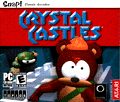 


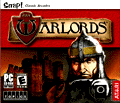
|
|
Our contribution to the Snap!
Classic Arcade series is primarily a spin-off of Atari: 80 Classic Games in One
in much the same way as the Atari
Pocketware collection spun off games from Atari Anniversary Edition.
Published by Topics
Entertainment, here, you get the games Crystal
Castles, Gravitar,
Millipede,
Pong,
and Warlords,
each in economically-priced solo packages, and
distributed at department stores and large-chain
retailers. The first four of these games (except
Warlords) derives directly from the Atari:
80 Classic Games in One arcade versions,
including all the same options and features, except for
the game-related multimedia.
The Warlords release is actually Atari's Warlords from
Atari Revival. That disk
features a fully modernised version of Warlords, by
another developer. For that disk, we contributed only the
bundled-in classic version of Warlords, as noted above.
Oddly, there is a sixth Snap! Classic Arcade
title with the Digital
Eclipse logo on it. That would be Combat. However, we
did not contribute to that one at all. It's actually the
recent Atari Revival
remake of Combat. As far as I know, it does not contain
any emulation of the classic version of the game at all.
At any rate, it definitely doesn't contain the version of
Combat we did for Atari: 80
Classic Games in One. I can only guess that
there was some confusion about our contribution to Atari Revival that lead to
this packaging error.
For what it's worth, I actually completed the work for
separating out these games in the Fall of 2003, after Atari: 80 Classic Games in One
shipped, but before the last versions of Midway
Arcade Treasures wrapped.
|
Midway
Arcade Treasures (Windows 98SE/2000/ME/XP) - Released 2004
 |
|
The package comes full circle. As noted above, Midway Arcade
Treasures for the consoles was partly a consequence
of a PC prototype we completed which merged Williams Arcade Classics, Arcade's Greatest Hits: The Midway
Collection 2, Arcade's Greatest Hits: The Atari
Collection 2, and the hitherto unreleased PC version
of Arcade Party Pak into a single CD
compilation. With the success of the runaway success of
the console version of Midway Arcade Treasures,
interest in the PC prototype was renewed. The 24 games
included are:
- From Williams Arcade Classics: Joust,
Defender,
Robotron,
Sinistar,
Stargate
and Bubbles.
- From Arcade's Greatest Hits: The Midway
Collection 2: Joust
2, Root
Beer Tapper, Splat!,
Spy
Hunter, and Blaster.
- From Arcade's Greatest Hits: The Atari
Collection 2: 720°,
Gauntlet,
Marble
Madness, Paperboy,
RoadBlasters,
and Vindicators.
- From Arcade Party Pak: KLAX,
Rampage,
Rampart,
Smash
TV, Super
Sprint, and Toobin'.
- Not previously released: Satan's
Hollow.
Aside from some fixes to make the games work on
operating systems that didn't exist when they were first
released (the original Williams Arcade Classics
was released within months of the debut of Windows 95,
and made use of the newly released DirectX 1!), there are
also a few things which make this compilation distinct.
- BurgerTime
and Moon
Patrol from Arcade's Greatest Hits: The
Midway Collection 2 were licensed games, not
owned by Midway. As they were not licensed for
this compilation, in their place we included the
Midway game Satan's Hollow.
- Since Arcade Party Pak was never
released for the PC before, this actually marks
the first official PC release for KLAX, Rampage,
Rampart, Smash TV, Super
Sprint, and Toobin'.
As to my contribution to this package, I created the
original Williams Arcade Classics and Arcade's
Greatest Hits: The Midway Collection 2 for the PC,
and had contributed Rampage to Arcade Party Pak.
The remaining games were done by Dan Filner, then a
Technical Director in our Emeryville office. As Dan was
busy on other things, I was responsible for the overhaul
of the games needed for the re-release, as well as
putting together the modest launcher that tied the
volumes together.
|
Atari
Anthology (Sony PlayStation 2, Microsoft Xbox) - Released 2004
 
View grid of Atari
Anthology unlockables and hot seat
challenge modes
|
|
Atari Anthology was another
dream project with an interesting history. We actually
first proposed a larger console-based Atari arcade
compilation to Atari
in December of 2001. That was shortly after the PSone Atari Anniversary Edition Redux went
out with 12 arcade games. With Atari:
80 Classic Games in One in 2003, we again revisited
the concept, this time considering bringing that package
to the consoles. It did take a while and several
permutations of the package, but we finally got the green
light in July of 2004, and our work was certainly cut out
for us to get the package out for US Thanksgiving 2004. The
compilation, at its core, features most all the
games from Atari: 80 Classic Games in One, but
also includes other, unique features:
- 18 classic Atari arcade games: Asteroids,
Asteroids
Deluxe, Battlezone,
Black
Widow, Centipede,
Crystal
Castles, Liberator,
Lunar
Lander, Gravitar,
Major
Havoc, Millipede,
Missile
Command, Pong, Red Baron,
Space
Duel, Super
Breakout, Tempest,
and Warlords.
Many of the arcade games included authentic and
"enhanced" presentations, which
featured variations on the game's graphics, such
as higher resolution or more colour.
- Officially, 67 classic Atari 2600 games: 3D
Tic Tac Toe, Adventure,
Air-Sea
Battle, Asteroids,
Atari
Video Cube, Backgammon,
Battlezone,
Blackjack,
Bowling,
Breakout,
Canyon
Bomber, Casino,
Centipede,
Circus
Atari, Combat,
Crystal
Castles, Demon
to Diamonds, Desert
Falcon, Dodge
'em, Double
Dunk, Flag
Capture, Football,
Fun
with Numbers (a.k.a. Basic
Math), Golf,
Gravitar,
Hangman,
Haunted
House, Home
Run, Human
Cannonball, Math
Gran Prix, Maze
Craze, Millipede,
Miniature
Golf, Missile
Command, Night
Driver, Off-the-Wall,
Outlaw,
Quadrun,
Radar
Lock, Realsports
Baseball, Realsports
Football, Realsports
Tennis, Realsports
Volleyball, Sky
Diver, Slot
Machine, Slot
Racers, Space
War, Sprintmaster,
Star
Raiders, Star
Ship, Steeplechase,
Stellar
Track, Street
Racer, Submarine
Commander, Super
Baseball, Super
Breakout, Super
Football, Surround,
Swordquest:
EarthWorld, Swordquest:
FireWorld, Swordquest:
WaterWorld, Video
Checkers, Video
Chess, Video
Olympics, Video
Pinball, Warlords,
Yars'
Revenge. (The three games in bold were new to
the line-up, having not appeared in the PC
version.)
- For each game in the compilation, up to five
"Challenge
Modes," which presented the
games in the psychedelic Trippy
Mode, the fast-paced Double Speed,
the roller-coaster Time
Warp mode (wherein the game
speeds up and slows down periodically), the
intense Time
Challenge (you have 1, 2, or 3
minutes to achieve a maximum score), or the
disorienting Hot
Seat mode (wherein you cycle
between 2, 3, or 4 games, changing every 10
seconds). Beat the challenge score in an arcade
game to unlock more challenge modes in the Atari
2600 library. (Look here
for a list of unlockables and Hot Seat
challenges.)
- A full multimedia bonus section, including the
ever-popular Nolan Bushnell interviews, and a
collection of Atari memorabilia and sales
material, including scans the manuals, boxes and
cartridges for every Atari 2600 game in the
compilation. (These scans were collected from our
resident classic game collector, Mike Mika, from
my own collection, and also courtesy of AtariAge as
well as several members of the classic arcade
collector community.)
- Also included in the bonus section are two
"hidden" prototypes, as also found in Atari:
80 Classic Games in One.
- Post your scores online with Xbox Live.
I set to the task of adapting my emulation core from Atari:
80 Classic Games in One to something suitable for
this latest compilation, and also designed the look and
feel of the compilation, in coordination with our
Vancouver-based Creative Director, Trent Ward.
As a matter of trivia, this compilation differs in the
game line-up by three games: Gone are Basic
Programming, Codebreaker,
and A
Game of Concentration, and in their place are Atari
Video Cube, Backgammon,
and Hangman.
One of the reasons for this is that it was felt that the
former three (and Basic Programming in
particular) just weren't going to work out as well on a
console, being keyboard games. For example, Basic
Programming had 24 keys, each having four distinct
colour-coded functions. To represent this on a console
controller, perhaps by navigating an on-screen keypad,
would've filled up so much of the screen in order to be
legible that there'd be no room to see the controls and
the Atari 2600 screen at the same time. The three games
that were chosen in substitution were games that we
hadn't been able to include in the PC version as the
legal research hadn't been completed in time.
Nonetheless, they were good games that we always wanted
to include, and now we could. They also served to round
out the Mind Games category from which the former three
were removed.
One of the features of Atari: 80 Classic Games in
One that had ended up on the cutting-room floor was
the Challenge Modes. The basic premise was that, in
addition to being able to play the regular games, we also
would have some variation on the game (runs faster,
looked different, etc.) in which you would have to earn a
specific score in order to advance to the next challenge.
It was something of a "meta-game" that was
meant to encapsulate the games within the compilation.
While there were some interesting framing ideas that were
eventually removed in the final design, the Challenge
Modes do remain in the compilation, and we do think they
add a lot. We'd be mesmerised by the Trippy Mode on more
than one occasion, and have a blast with the Time Warp
mode in a number of games.
With the game needing to be completed in such short
order, we definitely needed a lot of people on it. Blue Shift Inc.
was contracted to create the graphical interface used to
launch the games, and, later, our Vancouver studio
residents, George Phillips, Jeff Hanson, Chuck Chow, and
Clinton Blackmore, all fresh off their duties on Midway Arcade Treasures 2, jumped in to
lend a hand wrapping up things like the PlayStation 2 and
Xbox-specific code to support the emulators (controller
handling, drivers, etc.), Xbox Live support, in-game
interfaces and the like. Additionally, Atari loaned us
three very talented individuals from Humongous Entertainment
- Henrik Steen, Sam Baker, and Dave Anderson - to round
out the team. They were responsible for the sound
systems, bonus material interface and memory card/hard
disk management respectively. It was definitely a
monumental whirlwind effort to get the game done on
schedule. At one point during the project, I likened the
experience to trying to assemble a jigsaw puzzle in a
tornado.
It paid off, though, and all came together. We're very
pleased and satisfied with the final result.
On the down side, the intense demands of this project
dragged me quite a bit deeper into the project's coding
than I'd intended, and so it was something of a repeat
experience of the original Midway Arcade
Treasures in terms of 40-hour "days" (yes,
days), and several-day stretches that my family didn't
even see me. In fact, I believe that Atari Anthology,
though a shorter duration project overall, was more
intense in this way than Midway Arcade Treasures.
And so, I've strengthened my resolve that, going forward,
I'll not be engaging in direct programming tasks like
this again. (As it is, I've long ago moved beyond Lead
Programmer in the company, so I still had my "day
job" of CTO to tend to while providing key
programming on this project. The cumulative
responsibility and intense schedule left little time for
sleep.) There's only so many times one can do this sort
of thing, and I'm getting too old for it. :-) My mandate now is to hire
enough people to make sure that I, and others who shared
the same hours with me, can deal with projects on a more
sane time table.
Like Midway Arcade Treasures last year,
though, I'm certainly thrilled to finally see the
fruition of several years of hopeful conversations, as we
pushed to have such a massive compilation as this out
there for all the enthusiasts who share our passion for
these games. I grew up on these games, and keeping the
legacy alive like this has always been a mission for me.
Easter egg: to unlock all the
unlockables immediately on the PlayStation 2,
smultaneously hold down D-pad left, X and Triangle while
you press Start on the start screen. For the Xbox and
GameCube, use the buttons in the equivalent positions.
|
Other games to which I've contributed:
Arcade's
Greatest Hits: The Midway Collection 2 (Sony PlayStation) - Released 1997
 |
|
I contributed the emulation of BurgerTime,
designed certain aspects of the interface such as in-game
menus, and served as Technical Director. The package
featured emulations of the same games as found in the Windows 95 version and the other
releases. PSX cheat codes: (you heard it here
first!) While playing BurgerTime, pause the game, then,
while "Paused" is on the screen:
- 121 lives: Square, Triangle,
Circle, Square, Triangle, Circle, Square,
Triangle, Circle, L2
- 121 peppers: Square, Triangle,
Circle, Square, Triangle, Circle, Square,
Triangle, Circle, R2
Note: after entering the code, you must lose a life
for the cheat to take effect. Similarly, you have to use
a pepper to see the extra peppers after entering the
pepper cheat.
Trivia: due to some late-night goofiness, the
in-game credits end with the lines, "Best before
November 27th, 2097," and "Void if
removed." The "best before" date was
originally earlier (in 2014, I believe), but we were
asked to change it after some fear from production that
we might be implying a lack of confidence in the shelf
life of the game, since the longevity of the original
Sony PlayStation was, at that time, unknown.
|
Arcade's
Greatest Hits: The Atari Collection 1 (Super Nintendo) - Released 1997
 |
|
The game line-up for this Super
NES-based collection was the same as the PlayStation version. I contributed the
menu system infrastructure from my Super NES rendition of
Williams Arcade's Greatest Hits, and
also served as Technical Director, contibuting algorithms
and optimisations where needed. The main programming
was headed up by Matt
Schneider (Centipede, Missile Command, Tempest,
interface) and John Kowalski
(Asteroids, Battlezone, Super Breakout, sound).
|
Arcade's
Greatest Hits: The Atari Collection 2 (Sony PlayStation) - Released 1998
Addams
Family Pinball (Windows 95, Nintendo 64) -
Never completed

The physics / emulation test bed used to
develop the PC and N64 versions of Addams Family
Pinball. |
|
It was an ambitious project for the
time. Williams Electronics'
immensely popular Addams Family
Pinball table had sold nearly 30,000 units. A home
version was virtually demanded. In our rendition, our
talented Art Director, Boyd Burggrabe, had disassembled a
real-live Addams Family Pinball table piece by piece and
measured even the smallest screw. A detailed 90,000
polygon 3D model was built with the intentions of scaling
it down for use in the various target platforms. The
physics engine was equally ambitious... a full 3D engine
simulating the elastic and friction properties of the
materials in the table, and recognising both linear and
angular momentum in the balls. Thus balls could do all
the hops and oddities that are a consequence of spinning,
slipping, etc. A motion capture system was rigged which
tracked the ball behaviour in a real pinball table. The
parameters of the physics engine were tweaked to mimic
the motion captured behaviour as closely as possible. For
the table logic, the original 6809 code was run in our
well-established emulation technology, running both the
original ROMs as well as the limited edition Addams
Family Gold version of the game. I contributed the
emulation technology and lead the team on the physics
simulation. Jonah Beckford, a senior student from UBC Engineering Physics
contributed to the physics engine development. Frank
Linseisen, a then Research Associate in the Dept. of Physics at
UBC, designed and built
the motion capture system. (Frank also later helped out
on Rampage for the Game Boy Advance by providing some
sound processing tools.) Unfortunately, in
mid-progress, the viability of this product was
reconsidered and ultimately abandoned by the publisher.
In late 1999, Williams got out of pinball all together.
|
Rampage
World Tour (Game Boy, Game Boy Colour) - Released 1998
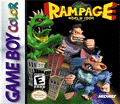 |
|
Rampage World Tour was one of a set of
three Game
Boy Colour games that Digital Eclipse
prepared for the launch of that platform in November of
1998. It was published by Midway
Home Entertainment and was a sequel to their popular
mid-'80s arcade game, Rampage. As
this was one of the first 3rd party GBC titles and the
platform was brand new, it was decided that this game
should be backward compatible with the older black-and-white
generation of Game Boy. Matt Schneider was the
lead programmer on that project. I provided some graphics
conversion tools and colour quantisers that freed the
artists from having to work around the unusual
restrictions placed on the GBC's screen. I also served as
Technical Producer on this project. Rampage World Tour
proved to be one of Midway's
most popular GBC titles. |
Centipede,
classic mode
(Sega Dreamcast)
- Released 1999
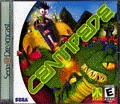 |
|
This was the classic mode of Centipede
found only in the Dreamcast version of Hasbro
Interactive's updated Centipede. The updated version was
developed by Leaping Lizard Software. Using a portable
emulation technique I'd developed, I created the
emulation core that ran Centipede. Craig Stewart at our
Vancouver office then integrated this into the Dreamcast
environment and with Leaping Lizard's development effort. |
Arcade Party
Pak (Windows 95)
- Unreleased
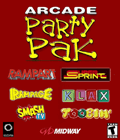
(mock-up box art)
|
|
This was to be the 4th PC
emulation volume from Midway. (The others were Williams Arcade Classics, Midway Collection 2 and Atari
Collection 2.) I contributed the emulation of Rampage,
since its hardware was similar to Spy Hunter and Moon
Patrol which I'd previously done in Midway
Collection 2. The rest of this PC version was
developed by Dan Filner, who'd also done the PC version
of Atari Collection 2. The other games in the
package included KLAX,
Rampart,
Smash
TV, Super
Sprint, and Toobin',
including interviews with the original designers. During
the course of development, quite a number of other games
were also emulated by Dan and myself (Wacko,
Timber,
Blasteroids,
Gauntlet
II, Two
Tigers, Satan's
Hollow, etc.) but they couldn't be used for
one reason or another (e.g. legal red tape). These PC
compilations are virtually impossible to find these days.
Some were only ever available in low quantities. However,
there was at one time word that they may be re-released
in Europe as Midway's Arcade Classics Volume 4.
In the meantime, you can still play Rampage on your PC
via Shockwave Arcade.
Addendum: in late 2004, the games from this
compilation finally saw the light of day! Now you can
play these games as part of Midway
Arcade Treasures for the PC, released in North
America by Encore.
|
Arcade Party
Pak (Sony PlayStation) - Released 1999
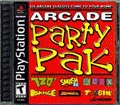 |
|
Our 5th classic compilation
to be released on the Sony PlayStation (after Williams
Arcade's Greatest Hits, Atari
Collection 1, Midway Collection
2, and Atari Collection 2). I
contributed the in-game menu system and served as Tech
Director. The package featured a slightly different
line-up than the PC version: KLAX,
Rampage,
720°,
Smash
TV, Super
Sprint, and Toobin'.
The reason was that the PC version of Atari
Collection 2 had included 720° (and Vindicators)
already in Atari Collection 2 (as substitutes
for Millipede and Crystal Castles, for which Midway no
longer had the rights). BTW, no, I never liked the
title of this package. Also, I found the constant
changing of the product line's name confusing.
|
Rampage 2:
Universal Tour (Game Boy Colour) - Released 1999
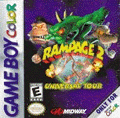 |
|
Rampage 2: Universal Tour was
technically the third Rampage title if you count the original
mid-'80s arcade version that inspired it all. This
time around Cathryn Mataga served as Lead Programmer,
building on the code originally created by Matt for Rampage World Tour. Primarily, I
shared the Technical Director role with fellow Digital Eclipser,
Mike Mika. My art conversion tools from Rampage World Tour were again
employed for a small portion of the art tasks; and, in
the role of Technical Director, I designed the algorithm
for the parallax scrolling effect -- for the Game
Boy Colour, this was an uncommon and difficult effect
-- which Cathryn then completed and coded into the game. |
Shockwave
Arcade (Windows 95, Mac) - Released 2000
 |
|
10 arcade games, free, playable straight
from your browser, and 100% emulated: Joust,
Defender,
Robotron,
Sinistar,
Stargate
(a.k.a. Defender II), Bubbles,
Spy
Hunter, Root
Beer Tapper, Rampage,
and Satan's
Hollow. I contributed the Intel-based
emulation core I'd developed for Williams
Arcade Classics, Midway Collection
2 and Arcade Party Pak to these
packages, refitted to be portable to the Mac. I took care
of the Mac adaptation of the 6809 core, while the
prolific twins, George and Peter Phillips, took care of
bringing over my Intel-optimised Z-80 core. Dale Van Mol
at our Vancouver office completed the integration of my
emulation core with the Windows version of Shockwave,
while Phil Freitas did the same on the Mac. I also served
as Tech Director on these projects.
You can play the final product yourself at www.Midway.com. Click on
the "Play Classic Games" link on their main
menu, or follow this
link.
|
Midway's
Greatest Arcade Hits 1 (Nintendo 64) - Released 2000
 |
|
After Shockwave, Phil and I moved on to
bringing six of these games (Joust,
Defender,
Robotron,
Sinistar,
Spy
Hunter, and Root
Beer Tapper) to the Nintendo 64. As before,
I contributed the emulation (including a newly written
sound board emulator optimised for the Nintendo 64) and
Phil wrote the Nintendo-specific code for graphics,
controls, menus, etc. I also provided some optimisation
strategies to get the frame rate solid. |
Midway's
Greatest Arcade Hits 1 (Sega Dreamcast) - Released 2000
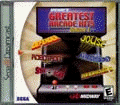 |
|
Same title, different
games. Still more confusion to an already-confused
product line (Williams Arcade Classics a.k.a. Arcade's
Greatest Hits a.k.a. Arcade Party Pak
a.k.a. Greatest Arcade Hits, and, for a
brief-though-unpublished time, Arcade Flashback).
Midway's Greatest Arcade Hits 1 was a port of Williams Arcade Classics from Windows 95
except without the interviews. So that's Joust,
Defender,
Robotron,
Sinistar,
Stargate
(a.k.a. Defender II) and Bubbles,
for those that are keeping track. This package used my
portable emulation core from the Shockwave
project. On this project, it was Dale that did the
platform-specific integration, with library coding was
from Craig Stewart (who'd previously worked on Centipede). |
Dragon's
Lair (Game Boy Colour) - Released 2000
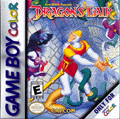
|
|
This was a very ambitious
project for the Game
Boy Colour. Dragon's Lair
was a ground-breaking arcade game of the early '80s
featuring, essentially, an interactive cartoon conceived
by renowned animator Don Bluth.
One of Digital
Eclipse's inventive programmers, Jeremy Mika, had
figured out how to render short FMV sequences on the GBC.
The effect had been used for the title sequence of Disney's
Tarzan (developed by Digital Eclipse,
published by Activision).
Jeremy had off-hand suggested that, with work, the same
effect could be used to render an entire FMV game and he
further suggested Dragon's Lair as the ideal subject. I
tracked down Dragon's Lair, LLC and it's executive, Rick
Dyer, and we struck a deal. Cathryn Mataga, who
previously worked on Rampage 2:
Universal Tour for us, took on the programming using
Jeremy's foundation code. Almost a year later and with
untold artist hours, the result was published by Capcom. Aside from
serving as Executive Producer on this title, I developed
several graphics and colour quantiser tools which
attempted to fit free-form traditional animation into the
GBC's peculiarly-restrictive palette requirements, and
other tools which improved image compression by doing a
specialised lossy-compression tailored to the GBC's
requirements.
This game has received very favourable reviews,
including an IGN Editor's Choice
Award.
|
Atari
Anniversary Edition (Sega Dreamcast) - Released 2001
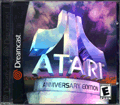 Cover art for
our unreleased Atari Arcade Hits from 2000:

|
|
It made it! In late 1999 and early 2000
when excitement for the Dreamcast was high, we took it
upon ourselves to bring Atari Greatest
Hits to the Sega Dreamcast. The Dreamcast version
featured the same 12 games (Asteroids,
Asteroids
Deluxe, Battlezone,
Centipede,
Crystal
Castles, Gravitar,
Millipede,
Missile
Command, Pong,
Super
Breakout, Tempest,
and Warlords),
original cabinet art, Nolan Bushnell interview, and other
multimedia content. I'd worked on the emulation core and
Craig (who'd previously worked on Centipede
and the libraries for Midway's
Greatest Arcade Hits 1 and 2,
all on the Dreamcast) did the substantial
Dreamcast-specific programming. This project was done
"on spec" (that is, without commitment from a
publisher). Due to the lack of confidence publishers
seemed to have in the Dreamcast, we spent all of 2000
shopping the game around without any luck. We'd all but
given up on our Dreamcast Atari compliation ever seeing
the light of day. Our "pre-beta" was officially
shelved around October of 2000. Then, at the end of 2000,
Infogrames bought
out Hasbro Interactive. With it, they acquired the rights
to the Atari library. Infogrames apparently had big plans
for Atari in 2001, not the least of which was a
celebration of the 30th Anniversary of the
creation of Atari Corp. They wanted to do a
multi-platform re-release of the Atari classics as part
of this celebration. So we dusted off the code and
promptly finished it up. Craig was on to other projects
by then, so Ryan (who previously worked with me on the PC version) and I finished it up. Atari
Anniversary Edition is the result.
As a matter of trivia, one variant
of our Atari compilations that didn't fare so well was
the one intended for the ill-fated Nuon
platform, the following year. The Nuon was originally
intended to be competition for the Sony PlayStation and
its contemporaries, but delays soon meant the
technology's market ambitions were scaled back to the
more modest role of providing enhanced functionality for
DVD players. Development proceeded on our Nuon-based
Atari compilation on spec, as well, but with definite
interest from VM Labs, creator of the Nuon.
Unfortunately, VM Labs didn't live long enough to see the
project's completion. Development on the Nuon version
paralleled what was done for the Dreamcast, with my
emulation cores being adapted and user interface added,
in this case, by Colin Fletcher.
|
Rayman
Advance (Game Boy Advance) - Released 2001

|
|
Rayman Advance was Digital Eclipse's
first product for the Game Boy
Advance. It was published by Ubi Soft and was
available simultaneously with the initial launch of the
GBA itself. Rayman is one of Ubi Soft's flagship
properties. This was the first time a developer outside
Ubi Soft itself had been allowed to work on a Rayman
game. Cathryn, who worked on Rampage
2: Universal Tour and Dragon's
Lair among other games for us, took on the Lead
Programming responsibilities.
In addition to serving as Executive Producer, I wrote
the graphics tools which freed the artists to work
outside the confines of the GBA's palette restrictions,
allowing them to create the rich, colourful worlds which
are the hallmark of this GBA game.
This game has received some very positive reviews,
particularly singling it out for its lush graphics as
well as solid game play. It has also received an IGN Editor's Choice
Award.
|
Spyro the
Dragon: Season of Ice (Game Boy Advance) - Released 2001
 |
|
Spyro the Dragon is without a
doubt the most ambitious project our Vancouver-based
branch studio of Digital
Eclipse had ever taken on as of 2001. It required
nearly the entire studio's staff, plus a number of key
support staff from the main Californian office. (In fact,
one of the California-based employees, Lars, made a noble
sacrifice and spent a whole six months in Vancouver
co-ordinating with the team.) The game consists of four
distinct engines: an isometric engine, created by Dale
(who worked on a number of the Dreamcast titles mentioned
above as well as our Shockwave
Arcade) is at the core of this adventure game; a
"speedway" engine for flight-racing rounds,
created by Craig (who also worked on a number of the
Dreamcast projects above); Sparx World (a top-down 2D
scrolling shooter) created by Adam from our California
office; and Dragonfly X (a bonus arcade-style mini-game)
created by Darren (a
new addition to our office, but an experienced game
programmer who's been at it since the Atari 800 days).
Additionally Phil (who worked on our Shockwave
Arcade for the Mac and our N64
Midway's Greatest Arcade Hits) provided the tools
that the artists and designers needed to build the game.
This team did an amazing job.
In addition to serving as Executive Producer and
Technical Director for this project, I provided tools
which assisted in the polygon-modelling of the isometric
worlds in order to encode collision and distance
ordering.
Visit the Spyro
the Dragon: Season
of Ice official site here.
|
Midway's
Greatest Arcade Hits 2 (Sega Dreamcast) - Released 2001

|
|
As with the original
volume, Dale and I worked on this follow-up, again
with me providing the emulation while Dale did the
platform-specific work using Craig's library. The line-up
started out like Midway Collection 2
but without BurgerTime.
The multimedia trivia game was dropped and the line-up
went through uncountable revisions and along the way
ended up being combined with a Volume 3 that'd already
been in progress (which was based on Atari
Collection 2). We were to continue with the best six
games chosen from both volumes, though these choices kept
changing. The final line-up was Gauntlet,
720°,
Paperboy,
Spy
Hunter, Moon
Patrol, and Rampage.
I provided the emulation for Spy Hunter, Moon Patrol
and Rampage, and did the port of Gauntlet from the Sony
PlayStation version. Pierre Tardif of our Vancouver
office ported Dan's emulation of Paperboy and 720° from
the Windows 95-based Atari Collection 2.
Despite having been 100% finished, approved, and ready
for the shelf since November 2000, time seemed to have
run out for the Dreamcast, and so it looked like this
product was never going to see the light of day. Yet, to
our surprise, Midway's Greatest Arcade Hits 2
was picked up by Best
Buy and EBgames
a year later and, as of November 2001, was
finally available!
|
Atari
Anniversary Advance (Game Boy Advance) - Released 2002
 |
|
Atari Anniversary Advance is
undoubtedly the premier classic compilation for the GBA.
It features an unprecedented six classic arcade games in
one hand-held package: Asteroids,
Battlezone,
Centipede,
Missile
Command, Super
Breakout, and Tempest.
plus an time-challenge Atari Trivia Game
that will challenge even the Atari fanatic. Atari
Anniversary Advance marks the debut of arcade
emulation on the GBA. Using the "Meta-Emulation
Technology" I developed for Digital Eclipse, these
classic games play with 100% authenticity. As with our
other compilations, the original operate settings are
also available. The games also feature multiple control
configurations with a quick-switch option, and optional
sideways modes for Centipede, Super Breakout and Tempest
to give them the authentic vertical-oriented look of
their arcade counterparts.
A lot of effort went into making this package a
reality. When Nintendo first announced the Game Boy
Advance, I immediately tried convincing Hasbro
Interactive -- and then Infogrames, after
they bought Hasbro Interactive -- that we should do a
classic Atari compilation on the GBA. Simultaneously, I
tried to sell Midway
on doing a compilation of their classic arcade games. I
had previously developed a technology that allowed
emulation on low-performance platforms, which would
promise the most accurate "ports" of these
games possible. The technology, Meta-Emulation, had been
originally been developed with the early 25MHz-or-so Windows
CE platforms in mind, but it was ideally suited to be
adapted to the GBA. Unfortunately, neither publisher
seemed ready to take the plunge.
I figured all they needed was to see a prototype and
they'd be sold. Since we did have to pay the bills, I
could only spare the development resources to do one
speculative prototype at a time. So, I chose Atari. (In
the middle of the Atari prototype, Midway changed their
minds but we didn't feel we had the time at that point to
do a proper job and still have it ready for Christmas.
So, Midway went with a different developer.) Thankfully,
Infogrames was suitably impressed with the prototype, and
after some debate over the details of the line-up, Atari
Anniversary Advance was born.
John
Kowalski was lead programmer on this project. He was
previously responsible for the sound in Williams
Arcade's Greatest Hits on the Super NES and was
co-programmer on Atari Collection 1
for the Super NES. John was responsible for taking the
"abstracted" meta-emulation of these games and
making them work specifically on the GBA. This project
also marked the first full project for Trent Ward, our
Vancouver office's new producer. Trent was also the
mastermind behind the trivia game in this compilation.
Trent was previously one of the founders of Next
Generation magazine, a company which at one time also
employed Digital Eclipse's executives Mike Mika and Chris
Charla.
Trivia: to improve the clarity of the vector
games like Asteroids which normally use very
high-resolution vector monitors, the technique of
sub-pixel rendering was used.
|
Spyro 2:
Season of Flame (Game Boy Advance) - Released 2002
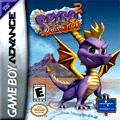
|
|
Our Vancouver office's first Spyro
effort, Season of Ice, was a
tremendous success. Naturally, everyone was enthusiastic
for a sequel. Not content just to pump out a retread,
however, Pierre, Spyro 2's Lead Programmer, elected to
redesign the code from the ground up. The result took
Spyro to a new level. Ryan Thom, who'd previously
contributed to Atari Anniversary Edition on the PC and Dreamcast,
joined forces with Colin, a newer hire to our office, to
provide an excellent level builder tool which allowed for
much fine-tuning of the levels. All new modes of game
play were also provided by Yvo, a recent EA "defector" :-), and Dale, who'd previously
worked on the core isometric engine of Spyro 1. Darren, who'd worked on
Dragonfly X and library support for the first
Spyro outing, provided an amazing resource pipeline
and robust library to pull it all together. On top of
that, we had a number of talented artists, programmers,
and designers contribute to the game on various levels.
It was a huge team by GBA standards, but it shows in the
depth and richness of the final product. In addition to
serving as Executive Producer and assisting in aspects of
the beta phase and European localisation, I, personally,
contributed one of the "Easter egg" bonus
games, but you'll have to be very good at the
main game if you are ever to see it. (No, it's not the
"Sparx Panic" game, as seen in the menu, which
unlocks if you finish the game. Sparx Panic was done by
Dale.)
Visit the Spyro
the Dragon's official site here.
|
Phantasy
Star Collection (Game Boy Advance) - Released 2002
 |
|
The original Phantasy
Star series is an old-school RPG series with a
dedicated following. (These days, Phantasy Star
is probably best known in its current incarnation as
Sega's Phantasy
Star Online.) Phantasy Star I appeared
originally on the Sega Master System with the sequels II
and III appearing on the Sega Genesis. When we
were given the chance to bring these games to the Game
Boy Advance, we wanted to do them the justice they
deserved. So, to give players the fully-authentic Phantasy
Star experience, we turned to meta-emulation for Phantasy
Star I and a line-by-line recreation from the
original Genesis source code for Phantasy Star II
and III. This project reunited a number of our
early emulation talent including John Kowalski
who first worked with us on Williams
Arcade's Greatest Hits for the Super Nintendo and
most recently before this on Atari
Anniversary Advance. John and I worked together on Phantasy
Star I in the same way we had with Atari
Anniversary Advance. I had expanded the
Meta-Emulation Technology originally developed for
Atari's arcade games to apply also to the Sega Master
System. We then applied this technology to bring a
code-perfect rendition of Phantasy Star I to the
Game Boy Advance. John's job was to write the
GBA-specific code that allowed the GBA to run my
"abstracted" meta-emulation. Drawing on John's
experience with sound coding, even the sound capabilities
of the Master System have been perfectly reproduced on
the GBA. So, even the music is an emulation.
Phantasy Star II and III were
brought to life on the GBA by "The Twins" :-) a.k.a. George and Peter
Phillips. George and Peter have also been working with us
from very early on. Their first game with Digital Eclipse
was Williams
Arcade's Greatest Hits for the Sony PlayStation,
released in 1996. Their experience on the Sega Genesis
and the availability of the original source made for a
very accurate port.
In addition to the "meta-emulation"
implementation of Phantasy Star I, I served as
Executive Producer on this project, mainly in a technical
capacity. Trent Ward, John's producer on Atari
Anniversary Advance, served as Producer on this
project as well.
Will Phantasy
Star IV or any of the other Phantasy Star
sequels appear on the GBA in the future? Well, I expect
that all depends on the how enthusiastic people are for this
GBA Phantasy Star trilogy...
(I've seen speculation in message
boards about whether more Phantasy Star games could've
been fit in this Collection's cartridge. Some people
argue that the GBA cartridge is bigger than the size of
the originals combined, so it should fit. However, the
thing they neglect is that the GBA uses a RISC processor, so it
takes a lot more bytes to accomplish the same
functionality. Additionally, since the GBA doesn't have
the same sound hardware as the SMS and Genesis, the sound
basically had to be stored in samples to do it right, and
that takes up a lot more space. Suffice to say,
if we didn't care about the quality of the games, we
might've been able to cram one or two more of the smaller
sequels into the one cartridge. However, they'd only be
pale imitations of Phantasy Star. Since we did
care about the quality, it was a struggle to make just
the first three fit in the cartridge. We think it was
worth it.)
|
Mini-games
in Terminator 3: Rise of the
Machines (Sony PlayStation 2, Microsoft Xbox) - Released 2003


|
|
This is a bit of an oddity. Terminator
3: Rise of the Machines was actually developed by Black Ops Entertainment.
Our contribution to it was none other than... Centipede
and Missile
Command! This T3 game was published by Atari, and this new Atari
is rightfully proud of its heritage. So, if you
successfully complete the game, you get to unlock a
couple hidden playable "mini-games" which turn
out to be none other than the old Atari classics Missile
Command and Centipede, brought to you
through Digital
Eclipse's classic arcade emulation technology. Sadly,
our contribution doesn't appear to be acknowledged in the
manual anywhere. (Though, I haven't checked the in-game
credits to see if it might be in there.) In any event,
to give credit where credit is due, my classic arcade
emulation core was incorporated on the PS2 by Ryan
(Centipede) and Yvo (Missile Command) and on the Xbox by
George (Centipede) and Yvo (Missile Command), all at our
Vancouver office.
Hopefully, this is the start of a trend of seeing
classic arcade games as mini-games in Atari releases.
|
Atari Paddle
Games 13-in-1 (Jakks Pacific TV Games) - Released 2004


|
|
This was a pretty unique and exciting
opportunity for us. A lot of us had a love of the classic
arcade and home games, but one continued source of
disappointment was the fact that the platforms on which
we'd recreate these games never quite had the right
controller to do the games justice. The opportunity to do
Atari 2600 paddle games on an exact replica of an Atari
2600 paddle was too good to pass up. The compilation
consisted of just about every Atari 2600 paddle game we
were legally cleared to do, as well as two paddle-like
arcade games. So the line-up was:
- the arcade games Warlords
and Pong;
and
- the Atari 2600 paddle games Breakout,
Canynon
Bomber, Casino,
Circus
Atari, Demons
to Diamonds, Night
Driver, Steeplechase,
Street
Racer, Super
Breakout, Video
Olympics, Warlords.
The reason for 13 games was this: it was thought that
a 10-in-1 paddle unit would be a great follow-up to the
hot-selling 10-in-1 Atari joystick. So, 10 Atari 2600
games were selected. Video Olympics didn't make the cut
because, out of 50 game variations in the original
cartridge, only two were one player. In addition to the
Atari 2600 games, we proposed adding the two
"bonus" arcade games, which brought the total
to 12. When it is was decided that there'd be a deluxe
two-paddle version of the unit, Video Olympics was
restored to the collection as an extra bonus, though
primarily for the benefit of those who bought the
"deluxe" model. The only paddle game from the
PC Atari: 80 Classic Games in One
that was not included was Blackjack,
but Blackjack was already represented as a game
within Casino.
By and large, the programming on this was a three-man
job. My task was preparing the games for the controller,
Peter Phillips did all the coding for the TV Games, and
Thomas Jentzsch (a 2600 enthusiast from the classic
gaming community) pitched in by helping do some of the
reverse engineering necessary to understand these games'
inner workings so that we could get them going on the
recreated hardware.
For my part, I'd written an Atari 2600 debugging
emulator (adapted from our earlier Atari 2600 emulation
core which formed part of Atari: 80
Classic Games in One). The debugger had a number of
features that would likely be of great interest to those
in the classic games coding community. Beyond the normal
ability to set breakpoints, view disassemblies, view CPU
state, and view execution traces back two frames, you
could also set breakpoints based on the raster position,
watch the raster step along as you single stepped through
the code, or click on any point on the TV output window
and see where in the trace the code was at that time.
Thomas and I both used this debugger to divine various
bits of information about how the game's kernel
constructed the screen, as needed to make the game work
on the recreated hardware.
The other part of my programming task was to shoehorn
arcade Warlords into something a little more
palatable for this hardware, since arcade Warlords
and the Atari 2600 had little in common aside from both
using a 6502-like CPU.
Beyond that, I'm proud of my low-res "programmer
art" rendition of the Atari 2600 that's used to show
the console switches, as well as my main menu art. :-)

|
Tron 2.0:
Killer App (Game Boy Advance) - Released 2004
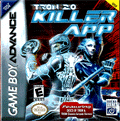 |
|
Tron 2.0: Killer App was a
monumental GBA game for our studio, and it was one I was
virtually begging to get placed with us. Tron is to
me what Star Wars is to many people. I loved the movie
and loved the games. (I've even got toy light cycles
autographed by Syd Mead.)
The team was largely lead by the same people who'd been
responsible for our Spyro GBA trilogy. Fresh off that
product, and with an unprecedented 128Mbit cart to work
with, the group crafted one of the richest games we'd
done to date. There is the familiar isometric view of
Spyro, but with two story tracks (one for Tron and one
for Mercury, the new Tron 2.0 character from Monolith's PC version).
That was lead by our Spyro
veterans, Pierre and Darren, with help from Colin and
Ryan (who'd also contributed to Spyro 3). Pierre also did
an excellent modernised light cycle mini-game, complete
with 4-way link play. There's a 3D tank/recogniser game
created by John
Kowalski, who'd pioneered 3D raycasting on the CoCo
3 and had done an actual 3D engine for a Game Boy Colour
version of San
Francisco Rush (which, sadly, was never released).
There are a tonne of mini-games accessed throughout the
isometric world. There's voice talent (including Rebecca Romijn
and Bruce
Boxleitner, yay!), and some amazingly catchy music by
our ever-reliable Senior Audio Engineer, Bob Baffy. And
last but not least, for the first time ever, the classic
arcade games Tron
and Discs
of Tron have been bundled in, in
meta-emulation glory. As Tron and Discs of Tron were
Z-80-based games, the tool set I'd developed for Phantasy Star Collection was dusted
off to do the work for these games. I'd laid the
foundations for this, both through the tool chain, and
through basic emulation of these games in Windows-based
reference environment. George Phillips (another long-time
emulation veteran with us) adapted the tool chain to the
specific needs of this project, and Vernon Brooks (a new
addition to our company, but also well-experienced in
emulation) did the adaptation and optimisations necessary
to make the games run smoothly and accurately on the GBA.
My other contribution to the project was design,
specifically in spec'ing out some of the mini-games (e.g.
the Spam mini-game) and also helping coalesce the initial
design on a technical level. Much of the detailed design
that followed, however, was a collaboration between
Creative Director Trent Ward, Producer Lorie Clay, and
Programmer Darren Schebek.
Overall, we're all extremely proud of how this game
turned out.
|
Midway Arcade
Treasures 2 (Sony PlayStation 2, Microsoft Xbox, Nintendo
GameCube) -
Released 2004
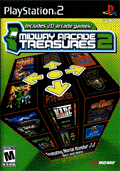 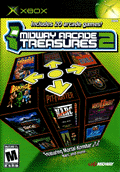
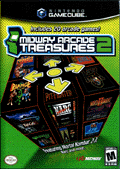
|
|
With Midway Arcade
Treasures being such a smash hit for Christmas 2003,
a sequel was inevitible. With Midway Arcade Treasures
2, we were finally able to do something we had been
contemplating for some time... We'd long been satisfying
our retro cravings for the big hits of the '80s, but what
about the '90s? Well, Midway Arcade Treasures 2
broke that barrier. The line-up included some of Midway's
big-name games from the early '90s, as well as some hits
we were forced to cut from Arcade Party
Pak. The line-up includes:
- A.P.B.,
Arch
Rivals, Championship
Sprint, Cyberball
2072, Gauntlet
2, Hard
Drivin', Kozmik
Krooz'r, Mortal
Kombat II, Mortal
Kombat 3, NARC,
Pit-Fighter,
Primal
Rage, Rampage
World Tour, Spy
Hunter II, Timber,
Total
Carnage, Wacko,
Wizard
of Wor, Xenophobe,
and Xybots.
- Commercials for these games, as well as video
interviews with some of the designers.
- The ability to post scores online via Xbox Live in
the Xbox version.
Some of the interviews for these games were actually
collected back in 1998 during a day-long interview
session in Chicago, where many of the luminaries from
Midway past and present gathered to share their thoughts
on these games. The remaining material, such as
commercials, came from Midway's archivists.
The programming team for this project was lead by one
of our emulation veterans, George Phillips. George worked
games for as far back as Williams Arcade's Greatest
Hits for the original Sony PlayStation, developed
back in 1996. The team was an unprecedented 11 core
programmers (unprecedented for emulation, anyway). Many
were new recruits, though many also had prior emulation
or classic architecture/gaming experience. Tasks were
largely split amongst the team by class of hardware,
since a number of the games might have been built on
similar arcade machine architectures. Most challenging of
the hardware, I believe, was the Hard Drivin'
architecture.
For this package, aside from providing the occasional
technical guidance, I also contributed the emulations for
Timber, Wacko, and Kozmik Krooz'r,
as well as some of the core that was adapted by Vernon to
form Wizard of Wor. On the console-specific side
of things, my memory card/hard disk management code was
adapted for this package as well, though I had little to
do with the actual adaptation. On the design side of
things, I contributed the concept for the main interface.
(Upon reflection, I found it amusing that my suggestion
of a microscopic "cellular level" theme was in
direct contrast to the cosmological theme I'd proposed
for Atari Anthology.)
Midway Arcade Treasures 2 is a fresh
direction for our classic compilations, and it has been
extremely well received. I can guarantee, with all the
enthusiasm we've seen, that there'll be more to come.
|
Midway TV
Games (Jakks Pacific TV Games) - Unreleased
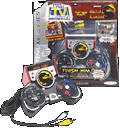 |
|
Announced,
but unreleased (as of yet, anyway), our Vancouver
studio worked on five games that were to be part of a
Midway-themed
follow-on compilation to Jakks Pacific's
successful Namco
and Atari
TV Games
controllers. The games we developed for the unit included
Joust,
Defender,
Sinistar,
Stargate
(a.k.a. Defender II) and Toobin'. For
the first four of those games, I implemented them in our
company's proprietary "Meta-Emulation
Technology". That technology had previously been
used in our Atari Anniversary Advance,
Tron, and Phantasy
Star Game Boy Advance products, to bring these
classic arcade and console games to the
moderately-powered GBA. Using this, I was able to adapt Defender,
Sinistar, Defender II, and Joust
to something compact, portable and still fast enough that
it could operate on the Jakks controller. Several other
programmers worked on fine tuning my "portable"
versions of these arcade games for the Jakks unit.
Specifically, Zach
Matley (who is well known in the Atari 2600 community)
worked on adapting Defender, John Kowalski
(who worked on Atari Anniversary Advance,
among other things) adapted Defender II and
Vernon Brooks (who worked on Tron)
adapted Sinistar and Joust. (I'd also
prepared a Robotron
meta-emulation, but that was never brought across, as
Robotron had a special controller style that didn't mesh
well with the other games.)
Toobin' was a more amibitious endeavour. It
went through quite a number of iterations and
programmers, with Brian Provinciano and Chuck Chow
ultimately bringing the game over through a lot of heavy
work in the form of code- and data-cramming.
One other spin-off of this project was the Mortal
Kombat TV Games unit. As
originally contemplated, it was all supposed to be
part of the one Midway TV Games unit. Mortal
Kombat eventually became a unit to itself. Mortal
Kombat's programming was largely a solo effort of Chris
Burke, who'd much earlier helped us out on Williams Arcade's Greatest Hits for the
Super NES, and had an earlier run-in with Mortal
Kombat in the form of an aborted port of Mortal
Kombat 3 to the Macintosh. For the Mortal Kombat
unit, I did contribute the initial hardware and protocol
design for the link cable that allowed us to link two Mortal
Kombat TV Games units together for head-to-head
play.
|
Namco
Museum 50th Anniversary (Sony PlayStation 2, Microsoft Xbox,
Nintendo GameCube, Windows 98SE/ME/2000/XP) - Released 2005
 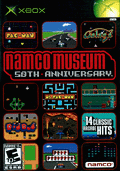
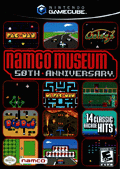

|
|
Namco 50th Anniversary was a
special comemorative compilation celebrating the 50th
anniversary of the formation of Namco (...not 50 years of
video games, of course, as amusing as it might be to
think about what steampunk
technology would've passed for an arcade video game in
1955). The compilation featured Pac-Man,
Ms.
Pac-Man, Galaga,
Galaxian,
Dig
Dug, Rally-X,
Pole
Position, Pole
Position II, Xevious,
Dragon
Spirit, Bosconian,
Rolling
Thunder, Mappy,
and Sky
Kid, with "secret" unlockables Galaga
'88 and Pac-Mania.
All are available together, for the first time, as 100%
emulation. I'd wager to say that Namco Museum 50th
Anniversary was the fulfilment of a long-standing
dream of its lead emulation programmer, Vernon Brooks.
Vernon joined the company about a year and half ago, and
his first project with us was the classic game component
of Tron 2.0: Killer App for the Game
Boy Advance. Vernon's calling card that got him the job
was a collection of extremely faithful emulations,
largely featuring Namco games. These were DOS-based and
deeply optimised with Intel-specific assembly code. So,
they were not really console-ready, but Vernon definitely
knew his stuff. Vernon's passion and pride for accuracy
showed through from the beginning. In fact, I believe he
joined us in hopes that, through Digital Eclipse's
reputation, he might one day be able to get these
accurate emulations out to the masses. Honestly -- and we
told him this up front -- we didn't hold out much hope,
since Namco had already released its Namco Museum line on
most of the current platforms. Much to our surprise and
delight, however, Namco approached us at the beginning of
the year to put together the 50th Anniversary
compilations.
These 50th Anniversary collections have all
been built from scratch, and precisely to Namco's spec.
They feature the most accurate emulations of these games
available, drawing on Vernon's well-honed expertise with
the architecture, and rounded out with our latest
generation proprietary cross-platform emulation
libraries, as initially applied in the first Midway Arcade Treasures. My programming
contribution lies primarily in that library, within the
6809 core, the Z-80 core that our George and Peter
Phillips previously adapted from its PC counterpart (way
back for Shockwave Arcade), and
the 6800 component that was adapted to serve as the basis
for the emulation for the more rare 63701 processor. My
code can also be found within the memory card/hard drive
management component. Additionally, I also performed some
of the modifications necessary for the Japanese market.
George Phillips served as the Technical Director, and
oversaw a dynamic team through the very intense
development cycle of this project. For a bit of
nostalgia, Ryan Thom, who had left our company after Midway
Arcade Treasures to pursue his own original game
idea with friend and office-mate Colin Fletcher, returned
under contract to provide support programming on this
game. I think Ryan was quite surprised to see how much
our studio had grown in the less-than-two years he'd been
gone.
This project came shortly after the formation of Foundation 9 Entertainment,
a cross-media company and mega-developer comprised of Backbone
Entertainment (itself comprised of Digital Eclipse
and ImaginEngine),
Collective
Studios, and Pipeworks
Software. A novel aspect of this project is that I
believe it marks the first official collaboration between
two studios under the new F9E umbrella. Specifically, the
3D engine employed in the console package's slick main
game selection interface was furnished courtesy of
Pipeworks, with our team collaborating directly with
theirs in its deployment.
Of course, if I'd had a hand in the interface
design, it definitely would've had a "50 Years of
Video Games" steampunk theme, complete with some
tongue-in-cheek bogus paraphernalia featuring video games
in 1955, wrecking the accuracy of documented history for
decades to come. :-)
|
Namco
Museum 50th Anniversary (Nintendo Game Boy Advance) - Released 2005
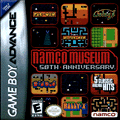 |
|
Namco Museum 50th Anniversary
on the Game Boy Advance was a more modest collection
compared to its console counterparts.
The Game Boy Advance version featured Pac-Man,
Ms.
Pac-Man, Dig
Dug, Galaga,
and Rally-X.
Like the console version, these games were rebuilt from
the ground up, using our proprietary Meta-Emulation
Technology. We also included a number of new touches that
we think enhance the game experience, including
full-screen sideways modes for traditionally
"portrait orientation" games like Pac-Man. On
the Game Boy Advance side of things, the implementation
was lead by John
Kowalski, whose experience from the Phantasy Star Collection was
extremely useful for his return to emulation in this
project. Like the console version, George Phillips, who's
likewise familiar with the process of classic emulation
on a GBA through Phantasy Star Collection,
provided Technical Director-style support for John.
Meanwhile, Vernon Brooks, who was the lead on the console
version, provided some of the basic groundwork in reverse
engineering these games, to get John started.
For my part, all games in Namco Museum 50th
Anniversary are Z-80-based, and employ my Z-80
Meta-Emulation code which was first deployed in Phantasy
Star Collection, with some improvements provided by
George. The project was a bit of a reunion. Ryan Thom, a
former employee who returned to us on the console
versions, also aided us in the Game Boy Advance version,
along with his business partner and fellow ex-Digital Eclipser,
Colin Fletcher. Their primary contribution was to the
game interface. Returning to us as well was Jeff Frohwein, an
extremely talented reverse engineer and Game Boy
afficiando who'd worked with our U.S. studio many years
ago on games like Mortal
Kombat 4 and the Spy
Hunter/Moon Patrol combo cartridge, both for the Game
Boy Colour. Jeff provided support in the final push of
the project.
|
Midway Arcade
Treasures 3 (Sony PlayStation 2, Microsoft Xbox, Nintendo
GameCube) -
Released 2005
 

|
|
One of the big mysteries for consumers
anticipating Midway Arade Treasures 2
the previous year was, "where did S.T.U.N.
Runner go?" S.T.U.N. Runner and the original
Mortal Kombat had originally been among the games to be
featured in Midway Arcade Treasures 2, but
neither turned up in the final product. Happily, we can
now explain this mystery. S.T.U.N. Runner was being held
back for Midway's follow-up Midway Arcade Treasures 3
driving-themed arcade compilation. As to Mortal Kombat,
it ended up on the bonus disk for Mortal
Kombat: Deception Premium Pack on the PS2 and Mortal
Kombat: Deception Kollector's Edition on the Xbox. Midway
Arcade Treasures 3 was a collaborative venture
between Digital Eclipse and China-based developer,
GameStar. Digital Eclipse provided the classic arcade
emulations, Super
Off Road (including the Track
Pak version), Badlands,
Race
Drivin' and S.T.U.N.
Runner, while GameStar provided the
adaptations of San
Franciscon Rush: The Rock Alcatraz Edition, Hydro
Thunder, San
Francisco Rush 2049, and Offroad
Thunder, plus the game menus. (Some of these
GameStar versions were based on the Dreamcast, rather
than arcade versions, particularly when the Dreamcast
games might've had enhancements over the arcade.)
For Digital Eclipse's part, the coding on Midway
Arcade Treasures 3 brought together many of the same
people who had worked on Midway Arcade Treasures 2,
using about half the MAT2 team. George Phillips
again served in the technical lead role, and my code is
again present in the Z-80 core, as used in Super Off
Road, and also some of the console framework,
though, it had been augmented.
We're happy to say that Midway Arcade Treasures 3
was a much more reasonably paced endeavour for us than Midway
Arcade Treasures 2. The emulation of the early 3D
driving hardware from Atari Games, used in S.T.U.N.
Runner and Race Drivin', has also been refined. As a fan
of driving games, I'm pretty happy with Midway Arcade
Treasures 3.
|
Capcom
Classics Collection (Sony PlayStation 2, Microsoft Xbox) - Released 2005
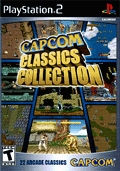 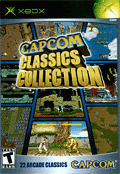
|
|
Capcom Classics Collection
marked a return to emulation programming for our talented
Emeryville-resident programmer, Dan Filner. The
compilation is an impressive array of Capcom games,
including 1942,
1943,
1943
Kai, Bionic
Commando, Commando,
Exed
Exes, Final
Fight, Forgotten
Worlds, Ghosts
'n Goblins, Ghouls
'n Ghosts, Gun.Smoke,
Legendary
Wings, Mercs,
Pirate
Ship Higemaru, Section
Z, Son
Son, Street
Fighter II, Street
Fighter II Champion Edition, Street
Fighter II Hyper Fighting, Super
Ghouls 'n Ghosts, Trojan,
and Vulgus.
This line-up brings the number of unique arcade games
emulated by Digital Eclipse to over 100. By and large,
it was pretty well a one-man show for Dan, though some of
the games in the package were implemented by Capcom
Japan. For those games developed by us here, at Digital
Eclipse, Dan employed the well-matured Digital Arcade
emulation library, developed primarily in our Vancouver
studio (though Dan himself contributed to it with the
PC-based Motorola 68000 and TMS34010 components that was
eventually adapted for console use). He also made use of
the Vancouver-developed console-specific support code
that plugged our emulation libraries into the PS2 and
Xbox. George provided support to Dan in the use of this
code, though once he got started, Dan rarely needed any
help. :-)
As in Midway Arcade Treasures 3,
my contribution is in this Vancouver-developed emulation
and framework code, through my part in the Z-80 core and
the memory card/hard drive support code.
|
Atari
Masterpieces Vol. I (Nokia N-Gage) - Released 2005
 |
|
Atari Masterpieces Vol. I for
Nokia's N-Gage
gaming phone is the latest rendition of these Atari
classics to use our proprietary Meta-Emulation
technology. I'd created this technology for Digital Eclipse
in 1999 to make it possible to run emulation on
lower-powered portable devices. Originally, it was
developed for Windows CE, but later adapted to the Dreamcast and Game Boy
Advance. (Yes, the Dreamcast and N-Gage are both
particularly more powerful, but the Windows
CE heritage fit well.) (This was not the first
N-Gage title developed by our company, but it was the
first one I had direct involvement in developing. The
more significant N-Gage title released from our Vancouver
studio was Rifts:
The Promise of Power, which was released earlier the
same year, and has received quite a number of accolades.)
The this compilation included:
- Arcade games:
Asteroids,
Battlezone,
Black
Widow, Lunar
Lander, Millipede,
Missile
Command, Red
Baron, and Super
Breakout.
- Atari 2600 games:
Adventure,
Surround,
Video
Chess, and Yars'
Revenge.
- Interviews:
amazingly, half the interviews with Nolan
Bushnell (which have previously appeared under Windows, Dreamcast,
PSOne, PS2,
and Xbox) also fit on
the game's tiny MMC card, courtesy of Cosmigo's Vipax
movie codec.
- Online score
boards: upload your high scores
in the eight arcade games to N-Gage's Arena online
score board.
One thing unique to this compilation was the
appearance of the Atari 2600 games on a portable device.
Outside Mike Mika's take on Yars' Revenge
for the Game Boy Color (obviously a labour of love, if
you know Mike), I'm not aware of any Atari-brand Atari
2600 games appearing on any portable devices.
(Incidentally, these days, Mike is head of our Emeryville
development studio.) The games selected for this
compilation where chosen for their ease of play on the
N-Gage platform and its controls, and for their ability
to be played solo. Of course, with such archetypal Atari
2600 games as Adventure and Yars' Revenge
in the line-up, this was no shortcoming. It does explain
why Combat
wasn't part of the collection, though. :-)
I provided the meta-emulation code for the arcade
games in this compilation, provided custom Atari 2600
emulations, and also provided support to Clinton, who was
the main guy for this title, charged with adapting these
games to the N-Gage-specific needs. Darren Schebek, veteran
of several of our GBA titles, also provided some support
on the N-Gage side of things (particularly with the user
interface).
The emulation of the Atari 2600 games was a
particularly interesting challenge. The main CPU of the
Atari 2600 is a modest 6502 running at less than 1MHz,
which is not difficult for the N-Gage to handle at all.
However, the code necessary to reproduce the Atari 2600's
rather primitive but CPU-intensive graphics pipeline was
not straightforward for even the PlayStation
2. The first attempt at getting that code operating
on the N-Gage achieved a frame rate in the vicinity of
4FPS. So, I had to pull off a few tricks to get the
performance adequate. Ultimately, for the game in
question, I started with our genuine Atari 2600 emulator
operating on the PC, and wrote a custom rendering routine
for each Atari 2600 that mimicked pixel-for-pixel
everything the Atari 2600 did. To ensure it was a match,
I would overlay my reconstructed screen (using an XOR
blend of the two images, for those that understand what
that means) to look at deviations between my
reconstruction and the authentic emulation. I'm
particularly fussy about these things, so even graphic
glitches in Yars' Revenge's explosion were reconstructed
accurately.
Interestingly, this was an opportunity to work with
Andy Mazurek again. Andy, for this project, was the
Nokia-based producer for the title. However, I'd
previously worked with Andy as a producer for Atari in
their now-defunct Beverly office. Together, we'd worked
on Atari Anniversary Advance for the
GBA, Atari Anniversary Edition Redux
for the PSOne, and Atari: The 80
Classic Games in One for Windows. Prior to that, he'd
led the Atari testing group back when I was developing
the original Atari Arcade Hits. So,
needless to say, he's as much a fan of these classic
games as we are, and was quite instrumental in this
project seeing the light of day.
Anyway, for those with an N-Gage looking for games
that are a quick fix, this is a great package. It's ideal
for those bus rides. :-)
|
Gauntlet,
Joust, Robotron: 2084, Smash TV (Microsoft Xbox 360 Live Arcade) - Released 2005
 


|
|
The launching of Microsoft's Xbox 360 opened up a
new and exciting market: online downloadables straight to
your video game console. The classic arcade games to
which we'd grown so attached were perfect for this venue
-- small download size, quick learning curve, and
addictive play. The four games available for Xbox 360
launch were Gauntlet,
Joust,
Robotron:
2084, and Smash TV.
We were quite proud, not only to be part of the Xbox 360
launch, but also to have our latest rendition of Joust
packaged into the first run of the Xbox 360 Live Premium
Starter Kits. With the Xbox 360 came some
interesting features:
Online Multiplayer:
broadband online play was a great boost to
multiplayer games like Gauntlet, Smash TV and Joust.
Gauntlet was truly meant to be played four-player. It's
only then that it reaches its full potential. In the
arcades, it was great to be able to find a group of
people playing Gauntlet, and join in as the fourth
player. Now, the Xbox 360 online experience recreates
that.
Robotron was a particularly interesting one. In its
original form, two players take turns playing Robotron.
However, we punched it up a bit, giving people a few ways
to play an intense head-to-head experience. The best way
to play is two-player simultaneous co-operative, wherein
one player shoots while the other moves, communicating
online through their headsets. That mode had our team in
hysterics. It was particularly riveting.
Enhanced Graphics: HD-TV
support meant that these games, in their original form,
those pixels were going to be pretty large and crisp
boxes. While that mode is available for those in a purist
mood, we took the opportunity to provide more detail to
the graphics, as we first did with Q*Bert
and the various Atari titles, in 1999.
That required a lot of meticulous and
painstaking work on the part of our artists, taking every
single frame, scaling up, retouching them, and adding
more colour. They also created some stylish backgrounds
for Robotron and Joust.
Since we were doing emulation, replacing the art was
no mean feat. These games -- every one of them -- built
their screens on the fly. For Robotron and Joust, there
was no ready-made "tile set" to replace.
Instead, it was a major reverse engineering task to
decipher where and how the screen was drawn. Then, that
code had to be intercepted, and code added to draw the
new graphics in parallel, over the original.
Achievements: Another
exciting enhancement was the addition of Achievements.
Play a flawless level, achieve a score in a certain
amount of time, etc. and you would earn points towards
your Gamerscore, a ranking in the Xbox 360 online
community. It was quite a lot of fun finding challenges
within each of these games, to count toward Achievements.
Like the graphics, it did take some effort to find the
code within the original ROMs that allowed us to tell
when these achievements had been met, though. I think we
probably know more about the innards of these ROMs than
anyone else can (or would want to) remember, at this
point. (The effort is somewhat a generalisation of the
"game state" reverse engineering I talked about
in my Gamasutra
article.)
For my part in this, as with a number of the classic
compilations, I contributed the classic emulation core --
here, for Joust and Robotron. I also worked with
Microsoft to get the project started, including spec'ing
out a number of the enhancements to these games, as well
as providing some of the reverse engineering support to
get the enhanced graphics in, and to detect the game
events necessary to implement the Achievements.
We think that the Xbox 360 renditions of these games
are the right balance, having the classic gaming
integrity (complete with authentic emulation) and still
providing some fresh excitement with the online features,
subtle graphics updates, and Achievements. With all the
enthusiasm these games are getting (some people are
saying this is what they spend most of their time doing
on their 360!), we're hoping we'll be getting the
opportunity to do this with more classic games soon.
Visit the Xbox
360 Live Arcade Marketplace to see more on these
enhanced, downloadable versions of Gauntlet,
Joust,
Robotron:
2084, and Smash
TV.
|
Midway
Arcade Treasures: Extended Play (Sony PlayStation Portable) - Released 2005
 |
|
The Midway Arcade Treasures
line features a lot of games that have been long close to
our hearts. Defender
and Joust
were two of the three games that ushered the first ever
available arcade emulation into the world with Digital Eclipse's
Digital Arcade Collector's Series. With Sinistar, they
were also among the six games for MS-DOS and Windows that
marked my first project with the company, when I started
back in 1994. They appear, here, over a decade later, in
the most authentic portable rendition ever. Midway
Arcade Treasures: Extended Play included a selection
of games spanning the first two volumes previous released
on home consoles, with an emphasis on the multiplayer
experience. The games included were:
- Multiplayer
Wireless games: Arch
Rivals, Championship
Sprint, Cyberball
2072, Joust,
Gauntlet,
KLAX,
Marble
Madness,
Mortal
Kombat, Mortal
Kombat II, Mortal
Kombat 3, Rampage,
Rampart,
Toobin',
Wizard
of Wor, Xenophobe,
and Xybots.
- Single Player
games: 720°,
Defender,
Paperboy,
Sinistar,
and Spy
Hunter.
The games in Midway Arcade Treasures: Extended
Play emphasise the multiplayer experience, with all
but five games featuring WiFi multiplayer in the PSP's
"adhoc" wireless mode (which means you don't
need a router or an Internet connection).
Unfortunately, as much as we would've liked to, these
games were too large to implement the PSP's Game Sharing
feature, wherein one PSP could upload a game to another
PSP for head-to-head play. (Emulation does carry some
additional size overhead, particularly when we had to
optimise for the PSP's processor and memory.) So, two
copies of the game are needed to take advantage of the
wireless features. In fact, the emulation of some of
these games were so large that, in some cases, the entire
game could not fit into memory at once. So, games like Mortal
Kombat and its follow-ons do experience some loading
delays between levels. Nonetheless, these games are
authentic emulation, not ports, and do run the original
arcade code.
For purists, we included an Easter egg/cheat code that
will allow you to play these games with their original
scale. To cycle through the other views, pause the game,
then hold down the L button and press the Square button.
The other views include 1:1 pixel scale, and original
aspect ratio.
With the PSP design not firmly established when this
project was first started, it provided some unique
challenges. The team worked intensely throughout this
project, adjusting as necessary, and investing a lot
of effort into optimising the games, in order to get a
solid frame rate, particularly in the Mortal Kombat
series. Latency-free networking, free of lag and stutter,
was also a particular challenge for these games. Since
they were emulation, we could not quickly resynchronise
the games if there was a network interruption. It was
particularly tricky to get these games to operate in
lock-step with up to four participants, and still having
plenty of time to retransmit without slowing down the
game if there was a signal issue. Both the optimisation
and the networking necessitated some particularly intense
nights near the last month or so of the project.
Nonetheless, our team was adamant to get it right, and a
lot of care was put into getting these games functioning
authentically.
For this compilation, I wrote the redesigned
networking protocol that ultimately went into the
package, allowing these games to be played over WiFi.
And, of course, I also provided my emulation cores from
the console versions, along with some support in adapting
them to the needs of the PSP.
|
Atari
Masterpieces Vol. II (Nokia N-Gage) - Released 2006
 |
|
Atari Masterpieces Vol. II for
Nokia's N-Gage
gaming phone follows on Vol. I
above. It was developed concurrently with Vol. I
by the same team, and complements the first line up
fairly well. The this compilation included:
- Arcade games:
Asteroids
Deluxe, Crystal
Castles, Centipede,
Liberator,
Pong,
Space
Duel, Tempest,
and Warlords.
- Atari 2600 games:
Air-Sea
Battle, Canyon
Bomber, Miniature
Golf, and Video
Checkers.
- Interviews:
includes the second half of the interview with
Nolan Bushnell started in Vol. I (which
have previously appeared under Windows,
Dreamcast, PSOne,
PS2, and Xbox), courtesy of Cosmigo's Vipax
movie codec.
- Online score
boards: upload your high scores
in the eight arcade games to N-Gage's Arena online
score board.
Development paralleled the first volume, and my role
was much the same. Aside from the line-up, the major
distinction was the ability to do head-to-head play in
Pong and Warlords.
|
Midway Arcade
Treasures: Deluxe Edition (Windows 2000/XP) - Released 2006
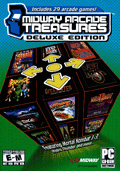 |
|
Midway Arcade Treasures: Deluxe
Edition is the packaging of the PC version of Midway Arcade Treasures 2 and Midway Arcade Treasures 3 into a single
box. The line-up mirrors the console versions, but with
the addition of Mortal
Kombat. The complete line up included:
- Midway Arcade Treasures 2 games: A.P.B.,
Arch
Rivals, Championship
Sprint, Cyberball
2072, Gauntlet
2, Hard
Drivin', Kozmik
Krooz'r, Mortal
Kombat, Mortal
Kombat II, Mortal
Kombat 3, NARC,
Pit-Fighter,
Primal
Rage, Rampage
World Tour, Spy
Hunter II, Timber,
Total
Carnage, Wacko,
Wizard
of Wor, Xenophobe,
and Xybots.
- Midway Arcade Treasures 3 games: Super
Off Road (including the Track
Pak version), Badlands,
Race
Drivin', S.T.U.N.
Runner, San
Franciscon Rush: The Rock Alcatraz Edition,
Hydro
Thunder, San
Francisco Rush 2049, and Offroad
Thunder.
- Additional multimedia including interviews,
photos, memorbilia, etc.
As with the console versions, Digital Eclipse was
responsible for all the games except the last four in the
MAT3 list above. Again, the two Rush
games as well as Offroad Thunder and Hydro
Thunder were ported by Gamestar, who also did the
front end for MAT3.
A number of people contributed to these compilations,
including Jeff Hanson (who led the port of MAT2),
Kevin Pickell (who led the port of MAT3), and
Luke Huang.
My contribution was similar to the console versions,
providing the full emulation of Timber, Wacko
and Kozmik Krooz'r, and the CPU emulation core
which was used in Wizard of Wor and Badlands.
I also served as "Technical Producer" for the
project, which is essentially a consultant role for the
emulation aspects.
|
Capcom
Classics Collection Remixed (Sony PlayStation Portable) - Released 2006
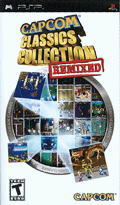 |
|
Dan Filner, who returned to us to do
Capcom Classics Collection, followed on with this PSP
compilation featuring a different line-up: 1941,
Avengers,
Bionic
Commando, Black
Tiger, Block
Block, Captain
Commando, Final
Fight, Forgotten
Worlds, Last
Duel, Legendary
Wings, Magic
Sword, Mega
Twins, Quiz
& Dragons, Section
Z, Side
Arms, Street
Fighter, Strider,
The
Speed Rumbler, Three
Wonders, and Varth.
(Some of the titles found in our console release but
absent in the PSP version will be found in Capcom
Classics Collection Reloaded, hitting the shelves
late 2006.) This compilation turned out extremely well,
I think. Building somewhat on the company's learning
experience of what worked and what didn't in Midway Arcade Treasures: Extended Play,
Dan was able to implement a number of features we had
wished we had been able to put into MAT.
For my part, I again contributed the original
emulation core for the 6809 and Z-80 based games (George
and Peter had helped on the latter), and also provided
Dan some insight on the WiFi protocols.
|
Konami
Classic Arcade series: Frogger, Time Pilot, Scramble, Contra,
Gyruss, Rush'n Attack, Yie Ar Kung-Fu, Super Contra, Track &
Field (Microsoft Xbox 360 Live Arcade) - Released 2006
 







|
|
Following on the surprise success of Xbox
360 Live Arcade and its initial Midway
launch titles, we've been inundated with many
opportunities to bring other classic arcade titles to the
Live
Arcade Marketplace, giving them the same fresh
treatment that the Midway games got. The first of these
to see release is Konami's
Frogger
-- helping roll out Arcade
Wednesdays on the service, just as our earlier Midway games helped roll
out the service itself -- followed by Time
Pilot, Scramble,
Contra,
Gyruss,
Rush'n
Attack, Yie
Ar Kung-Fu, Super
Contra and Track
& Field released
periodically through the remainder of 2006 and into 2007.
Like their predecessors on Live Arcade, we've taken the
opportunity to enhance the games with some features that
add new dimensions to game play, while staying true to
the game's core: Online
Multiplayer: though Frogger and others
are not a head-to-head game by nature, the widescreen of
HDTV makes it very easy to play two games side-by-side,
trying to best your opponent's performance overall,
within a time limit, or team up to get the best combined
score.
Enhanced Graphics and
Sound: our guys decided to push the
enhanced graphics a little further in this second round,
complete with particle effects for the vehicle exhaust
and the like. It's a much more vibrant playfield, while
keeping the original spirit. Likewise, the sounds were
enhanced, though they stay genuine to their original
cues.
Achievements: complete
up to Level 5, complete Level 1 in less than 45 seconds,
fill the slots in order, etc. for special recognition
through Microsoft's Achievements.
The development for these games followed the model for
their Midway predecessors, but
refined. Confident in the fundamentals, we pushed the
graphics enhancements further, pushed the sound further,
etc. for a well-polished package. The team was led by
Josh, newly hired for our Xbox Live Arcade projects, with
a little help from "Snake" and George. Vernon,
who did our Namco emulations,
amongst others, adapted my emulation cores to these
games. Production was led by Rick. For my part, aside
from providing the basic CPU emulation core, I was also
involved early on in the negotiation and planning of
these games. The Konami games also feature the first
contributions, in the form of the enhanced art, to a
released product from our Charlottetown,
PEI studio, our second Canadian studio, which I
helped establish in the beginning of 2006. Jamie and Matt
were the artists involved there.
Visit the Xbox
360 Live Arcade Marketplace to see more on the
enhanced, downloadable versions of Frogger,
Time
Pilot, Scramble,
Contra,
Gyruss,
Rush'n
Attack, Yie
Ar Kung-Fu, Super
Contra and Track
& Field.
|
Konami Live!
Online Game Controller Arcade Collection (Windows XP) - Released 2006
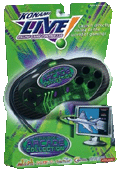 |
|
This came as a bit of a side project to
our Konami Xbox Live Arcade
project. It was definitely an interesting and novel idea
in the vein of some of the TV Games
that we had done, but instead of plugging into your TV,
it plugged into your computer's USB port. The game
collection would automatically install when the
controller was plugged into your PC and then
self-configure. It was advertised with five games -- Contra,
Gyruss,
Scramble,
Time
Pilot, Yie
Ar Kung Fu, and a "bonus sixth
game" later revealed to be Track
& Field. The emulation cores were based
on the same code we'd developed for its Xbox Live Arcade predecessor, so PC
users get both the original and enhanced modes available
to Xbox Live Arcade. Check out the Official
Site for more, including the TV spot featuring a
scruffy guy in a tutu appearing in a grounded kid's
locked bedroom unbeknownst to the parents. He has
presents, too, but it'll be their little secret.
|
Midway
Classic Arcade series: Defender, Root Beer Tapper (Microsoft Xbox
360 Live Arcade)
- Released 2006
Sega Genesis
Collection (Sony PlayStation 2, Sony PlayStation Portable) - Released 2006
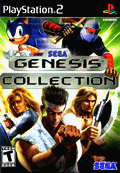 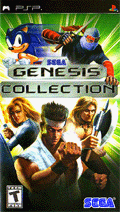
|
|
These games were again programmed by Dan
Filner, our emulation power-house South of the border.
(Well, technically, very, very, South-West as he wrote
these things, since he was "on sabbatical" with
his girlfriend in New Zealand at the time.) Still, the
package had plenty of veteran support when needed, George
Phillips, Peter Phillips and I contributed the Z-80
emulation, Steve
"Snake" contributed his Sega expertise and
the YM2612 sound emulation, and Vernon Brooks (who
previously worked on some of our Midway
and Namco collections as well as
the classic arcade games in our GBA Tron
2.0: Killer App, among other
things) contributed the arcade emulation bundled in the
package. (I also was there for Dan on the PSP networking,
for the rare question he had.) Sega Genesis
Collection is not only an excellent compendium of
the Sega
Genesis home game console of the late '80s and early
'90s, but also contains a few arcade titles. The full
line up includes:
- Classic Sega Genesis titles: Alex
Kidd in the Enchanted Castle, Altered
Beast, Bonanza
Bros., Columns,
Comix
Zone, Decap
Attack, Ecco
the Dolphin, Ecco:
The Tides of Time, Ecco
Jr., Flicky,
Gain
Ground, Golden
Axe, Golden
Axe II, Golden
Axe III, Kid
Chameleon, Phantasy
Star II, Phatasy
Star III: Generations of Doom, Phantasy
Star IV: End of the Millennium, Ristar,
Shadow
Dancer: The Secret of Shinobi, Shinobi
III: Return of the Ninja Master, Sonic
the Hedgehog, Sonic
the Hedgehog 2, Super
Thunder Blade, Sword
of Vermilion, Vectorman,
Vectorman
2, and Virtua
Fighter 2.
- Bonus arcade games in PS2 version: Altered
Beast, Future
Spy, Tac/Scan,
Zaxxon,
and Zektor.
- Bonus arcade games in PSP version: Astro
Blaster, Congo
Bongo, Eliminator,
Space
Fury, and Super
Zaxxon.
- Bonus material including history, box art, and
tips.
- Adhoc network WiFi play on the PSP version.
The Z-80 emulator core appears in the arcade games
plus the sound component of the Sega Genesis.
Appropriately, a number of the people on this project had
also been programmers for the Sega Genesis in its day.
And, with some hint of irony, Dan, George and Peter had
actually programmed a classic compilation for
the Sega Genesis itself, in the form of Williams
Arcade's Greatest Hits, back in 1996.
|
Capcom
Clasics Collection Volume 2 (Sony PlayStation 2, Microsoft Xbox) - Released 2006
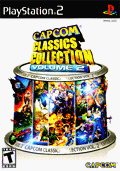 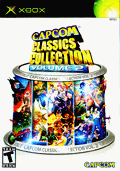
|
|
Dan Filner was a busy, busy man in 2006.
Not only did he deliver the first Capcom
Classics Collection for the PSP (and contributed on
the other platforms), and not only the Sega
Genesis Collection, but also was practically the solo
coding force behind Capcom Classics Collection Volume
2 for the PS2 and Xbox. He did turn to the portable
Z-80 emulation core that George, Peter and I had
developed, and my 6809 CPU emulation core, but other than
that he was his usual one-man army. The line-up for Capcom
Classics Collection Volume 2 includes:
- Arcade game line-up: 1941:
Counter Attack, Avengers,
Black
Tiger, Block
Block, Captain
Commando, Eco
Fighters, The
King of Dragons, Knights
of the Round, Last
Duel, Magic
Sword, Mega
Twins, Quiz
& Dragons, Side
Arms: Hyper Dyne, The
Speed Rumbler, Street
Fighter, Strider,
Super
Street Fighter II Turbo, Three
Wonders, Tiger
Road, and Varth:
Operation Thunderstorm.
- Bonus material: history, trivia,
artwork, tips and music tracks.
|
Activision
Hits Remixed (Sony PlayStation Portable) - Released 2006
 |
|
...and so it comes full circle. There's
a lot of history here. My first brush with the video
game industry was in 1993, a year before I joined Digital Eclipse.
Driven on by recreating many of my favourite computer and
game experiences from my childhood and teens, I had
turned my attention to creating an Atari
2600 emulator. At the time, it was commonly believed
that an Atari 2600 emulator couldn't be done on the
technology of the day, due to the excessively alien
nature of the Atari 2600. It would require a lot
of code overhead to make a PC act enough like the Atari
2600 to run its programs. No Atari 2600 emulator existed.
Despite the challenge, I did manage to create an
all-assembly-code emulator that was capable of running a
slightly buggy, soundless version of Activision's Pitfall
and Sky
Jinks, plus Atari's
Combat
(all at up to 120FPS on a 20MHz 286!).
I thought it would be great to get an official
compilation out there, bundled with licensed ROMs. (There
was no MAME back then, and no emulator ROM controversy at
all. The only arcade ROMs that were online was an archive
for game collectors to burn replacements in order to
repair their original cabinets.) With the assistance of a
person by the name of David Sutherland in California
working as my "agent", I tried to attract the
interest of Atari,
first. The response from Atari was not pretty. First,
they responded that this emulator was using proprietary
know-how and thus was illegal. I persuaded them that this
was not the case, and I wanted to work with them
to release it. Unfortunately, once they understood, they
had no interest in publishing such a package for these
"old" games; Atari was focusing on the future:
the Atari
Jaguar.
Next stop was Activision.
Most of the games I loved best on my Atari 2600 were
Activision games, anyway, I figured. It's a good bet.
Well, we caught them at a curious time. They were only
about a month or two into pre-production on Atari
2600 Action Pack, and were in negotiations with Livesay Technologies
to develop the package. My "rep", David, took a
copy of my prototype into a meeting with Activision's
then-CEO, and nearly won the contract away. One snag
stopped us: my emulator was an MS-DOS-based emulator, and
they wanted an emulator that ran in Windows 3.1. I tried
unsuccessfully to sway them to the merits of my
MS-DOS-based solution. True, I had never actually
programmed in Windows before, but I felt I could learn
and so didn't see that as the big hurdle of compliance.
Rather, the problem was that I was a purist. I didn't
think that these games should be played in a window on a
desktop; they had to be full screen. That wasn't going to
happen under Windows 3.1. I tried to persuade them that
the way to go was a Windows-friendly installer/launcher
to a DOS program, but they wouldn't go for it. So, they
continued with Livesay Technologies, and that was just
about that. I did contribute to the Atari 2600 Action
Pack in one very small way: I contributed the ROM
images of Laser
Blast and Cosmic
Commuter which I'd managed the extract using a very
homebrew ROM reader (two computers' parallel ports wired
directly to the address/data lines of the cartridge using
only a custom cable!). I got a free copy of the game for
my troubles.
(As a small aside, when I joined
Digital Eclipse the next year to create Williams Arcade Classics -- as a
result of them seeing my TRS-80 Colour Computer 2
emulator -- they also wanted a Windows 3.1-based
emulator. That time, I was successful in
persuading Andrew Ayre, President of Digital Eclipse,
that a DOS-based emulator with optional Windows-friendly
wrapping was the way to go. Activision rejected the
option for fear of it not being sufficiently
user-friendly. So, I feel vindicated in that I later was
told that Williams Arcade Classics for
MS-DOS/Windows 3.1 got the least tech support calls per
units sold of any PC product GT Interactive
had ever published to that point.)
Ten years later, I got to fulfil my goal to create an
Atari 2600 emulator, even if it wasn't to be the first
one out there, via Atari: The 80
Classic Games in One. And, the compilation featured
the first-party game catalogue of my original
publisher-hopeful, Atari.
Meanwhile, it seemed like Livesay Technologies had the
lock on emulation for Activision, at least up until its
last incarnation as Activision
Anthology on the PlayStation 2, developed by Contraband
Entertainment. To my surprise, we were contacted in
the spring of 2006 by Activison.
They were looking for someone to develop a version of Activision
Anthology for the Sony
PSP for Christmas 2006. Now, the manufacturing time
for video games can be quite long. What this really meant
was that there were only five months to do the game.
Happily, they decided that there was only one company out
there with the experience in both the Sony PSP and
emulation (Atari 2600 emulation, in fact, thanks to Atari:
The 80 Classic Games in One and the
confusingly-named Atari Anthology):
That would be Digital
Eclipse.
I had wondered if I should list this game under my "Lead Programmer" section
above, since the emulator itself is entirely my code
while the user interface was done by others, much as some
of the other compilations I led. However, truth be told,
it was basically the same emulator I developed for
Digital Eclipse that was included in our previous PC and console
Atari compilations. I did consult on and support the
project periodically, but it would be wrong to say I led
it in this case. I supported my emulator for use in this
product -- debugging as needed, optimising it for the
Sony PSP, and adapting it to support some quirks unique
to Activision games -- but the bulk of the work was done
before this project ever started. I contributed probably
two or three weeks' worth of my work time to
emulator-specific tasks on this project. (Actually, in
terms of code I contributed, it also makes use of the
WiFi protocol I developed for Midway
Arcade Treasures: Extended Play on the Sony PSP.) I
also supported the team by reverse engineering the data
they needed to extract for unlockables (scores, game
levels, etc.), by rewriting our PSP sound code to support
the emulator, by helping optimise the entanglement of
renderer and WiFi servicing, and by dealing with some of
the game control issues. Basically, I worked on anything
specific to the emulator itself that needed to be done
specifically for this Activision project. This was all
"on the side" to my real job, which had become
more along the lines of business development. (So,
officially, I was the guy who actually negotiated this
contract and dealt with Activision on a business level.
It was also the last project I signed to the Backbone
Vancouver studio of our
company in my capacity as Studio Head, which I
relinquished in June of 2006.) I couldn't help but get
involved, though, given how long-coming this opportunity
had been.
The team that did the bulk of the new work was Ryan
Thom and Colin Fletcher, both returning to us under
contract after leaving to start their own company
and create their own
game. Joining them on coding was new hire Porter,
focusing on network issues, and George Phillips, our
Vancouver-based Technical Director and frequent emulator
contributor (from as far back as 1996!). George oversaw
the integration of my "platform agnostic"
emulator with the Sony PSP code. Interestingly, Ryan
Thom's first full project with Digital Eclipse was to
assist me with Atari Arcade Hits 1
back in 1999, and Colin's first project was the aborted
Atari Arcade Hits for the Nuon
system. Rounding out the team and enhancing the reunion
factor was the return of artist Boyd Burggrabe, who'd
first worked on the cinematics for our PlayStation 1
retro compilations and had been Digital Eclipse's Art
Director from the Addams Family
Pinball project in 1997 until he left to form Lucky Jump Games
in 2005. Paige Meekison of our Vancouver studio served as
Producer.
Activision wanted us to re-imagine the art style of Activision
Anthology to give it a more "neo-art-deco"
feel for the Sony PSP. Development-wise, Boyd created the
art, Ryan and Colin put the UI together and married it
with the emulator George helped attach to the PSP code.
Then Porter connected up the networking, and I helped
prepare and debug the emulator, and optimise the whole
thing. What came out of the whirlwind event was:
- 44 games from
Activision and Imagic's Atari 2600 library: Atlantis,
Barnstorming,
Beamrider,
Boxing,
Bridge,
Checkers,
Chopper
Command, Cosmic
Commuter, Crackpots,
Decathlon,
Demon
Attack, Dolphin,
Dragster,
Enduro,
Fishing
Derby, Freeway,
Frostbite,
Grand
Prix, H.E.R.O.,
Ice
Hockey, Kabobber,
Kaboom!,
Keystone
Kapers, Laser
Blast, Megamania,
Moonsweeper,
Oink!,
Pitfall!,
Pitfall
II: Lost Caverns, Plaque
Attack, Pressure
Cooker, Private
Eye, River
Raid, River
Raid II, Robot
Tank, Seaquest,
Skiing,
Sky
Jinks, Space
Shuttle, Spider
Fighter, Stampede,
StarMaster,
Tennis,
and Thwocker.
- Game Share WiFi
play: using only one copy of
Activision Anthology, you can transmit a copy to
a nearby PSP via WiFi and play games
head-to-head, wireless.
- Unlockables:
all the unlockables, and Activision
Patch achievements of Activision
Anthology. (Note: some of the unlockable
thresholds have been changed in our version, to
match the original games' thresholds for earning
patches, rather than the modified threshold of Activision
Anthology on the PS2.)
- An '80s soundtrack:
featuring 12 pop music hits from
the 1980s, including "Take
On Me" by a-ha,
"No
More Words" by Berlin,
"The
Tide is High" by Blondie,
"The
Safety Dance" by Men
Without Hats, "Walking
in L.A." by Missing
Persons, "Always
Something There to Remind Me" by Naked
Eyes, "Harden
My Heart" by Quarterflash,
"Tainted
Love" by Soft
Cell, "Pulling
Mussels (from a Shell)" by Squeeze,
"It's
My Life" by Talk
Talk, "We're
Not Going to Take It" by Twisted
Sister, and "Mexican
Radio" by Wall
of Voodoo. (These songs are here
"remastered" to be MP3 quality stereo,
rather than mono like the PS2 versions.)
I was thrilled to finally have a chance, after so many
years, to do my part to keep these Activision gems alive.
This project also feels like the end of an era to me,
marking the conclusion of a quest that started 13 years
previous, and also marking the last game I signed on as
head of the
studio I established and helped build in Vancouver. I
spent the remainder of 2006 with the company, but in a new,
exclusively business (vs. blended with game production)
role, before moving on at the end of the year. The
company itself has changed
and grown so much in 2006, further punctuating the
transition. It's an appropriate conclusion, for sure.
|
Commodore
64/VIC-20 Backgammon
In 1985, while still in high school, Geoff
Rideout and I wrote a Backgammon game on his Commodore VIC-20. We
were both Backgammon enthusiasts and wanted to do something fun
with his computer. Geoff and I worked together on the AI design
and debugging, while I did the initial programming. It wasn't an
overly ambitious project, but we decided to submit it to various
hobbiest magazines to see what they thought.
Our first choice was Run! magazine (an affiliate of
the TRS-80 magazine "80 Micro" which inspired my
whole venture into emulation four years later). We were rejected.
Disappointed but not defeated, we submitted to the
more-widely-known Compute!'s Gazette. It was accepted
and, to our glee, featured prominently on the cover of the November 1985 issue.
We were also thrilled with the ~$200 cheque we'd received and
split evenly for the article. Little did we know that the
"real money" would be arriving in the months that
followed when the royalties started coming in on Compute!'s
Gazette on Disk.
Backgammon was subsequently re-issued in Compute!'s Third
Book of Commodore 64 Games. Again, pleasantly, Backgammon
featured prominently on that cover.
(Of course, royalties eventually dwindled. After maybe a year
of no activity, I recall our last cheque that closed the account
was for $0.09.)
View enlargements of the covers, plus
a screen shot of the Commodore 64 Version
Play a
Java version here...
Activision
Patches
Here's a list of the Activision club patches I've got for
their Atari 2600 games. For more details, visit the Activision Patch Gallery at the AtariAge site.
I no longer have my high score list, unfortunately, though
there was a time I held four Canadian and two world records. I
can only recall, now, that one of them was in Grand Prix. (I'm
not making this up. :-) I'm fairly
certain it's documented in an Activision Canadian-edition club
newsletter somewhere. At the prompting of a co-worker, I did find
the one that mentions the two world
records. Unfortunately, the reign was short-lived. I believe
the scores were toppled within months.)
- Frostbite Bailey's Arctic Architects (Frostbite)
- Spider Fighters (Spider Fighter)
- Sky Stars (Sky Jinks)
- Commander, Activision Federation of Laser Blasters (Laser
Blast)
- 1,000,000 !!!!!! (Laser Blast) [perfect score - 1,000,000]
- River Raiders (River Raid)
- All-Star Hockey Team (Hockey)
- No Plaque Pack (Plaque Attack)
- Megamaniacs (Megamania)
- Roadbusters (Enduro)
- Grand Prix Driving Team (Grand Prix)
- Space Shuttle Pilot (Space Shuttle)
- Beamriders (Beamrider)
- Billy Club (Keystone Kapers)
- Star of Honor (Robot Tank)
- Explorers' Club (Pitfall) [perfect
score - 150,000]
- Explorers' Club (Pitfall II)
- Save the Chicken Foundation (Freeway)
- Order of the Supreme Starmaster (Starmaster)
- Wing Commander (Star Master)
- Leader (Starmaster)
- Starmaster (Starmaster)
- Chopper Commandos (Chopper Command) [perfect score - 999,999]
I seem to have lost two of my Robot Tank patches. (I only had
three of the four available.) If anyone know's where I might get
replacements, please let me know.
All content ©2000-2008 Jeff Vavasour. Updated November 07, 2009.

































































































